Indochina, Marshall Petain, Michel Nr. 282-287; Various nominal values of this stamp were issued over a period of almost two years. According to Michel the stamps were issued as follows:
1C = September, 8th, 1942
3C = June 29th, 1943
6C = July 1st, 1942
10C= December 1st, 1943
40C = January 15th, 1943 (blue-green)
40C = April 1st, 1944 (blue)
The general perforation for this set was 11.5 but there are numerous perforation varieties that were issued. The are addressed below.
Here is a mint block of four of the !C stamp in perforation 11.5
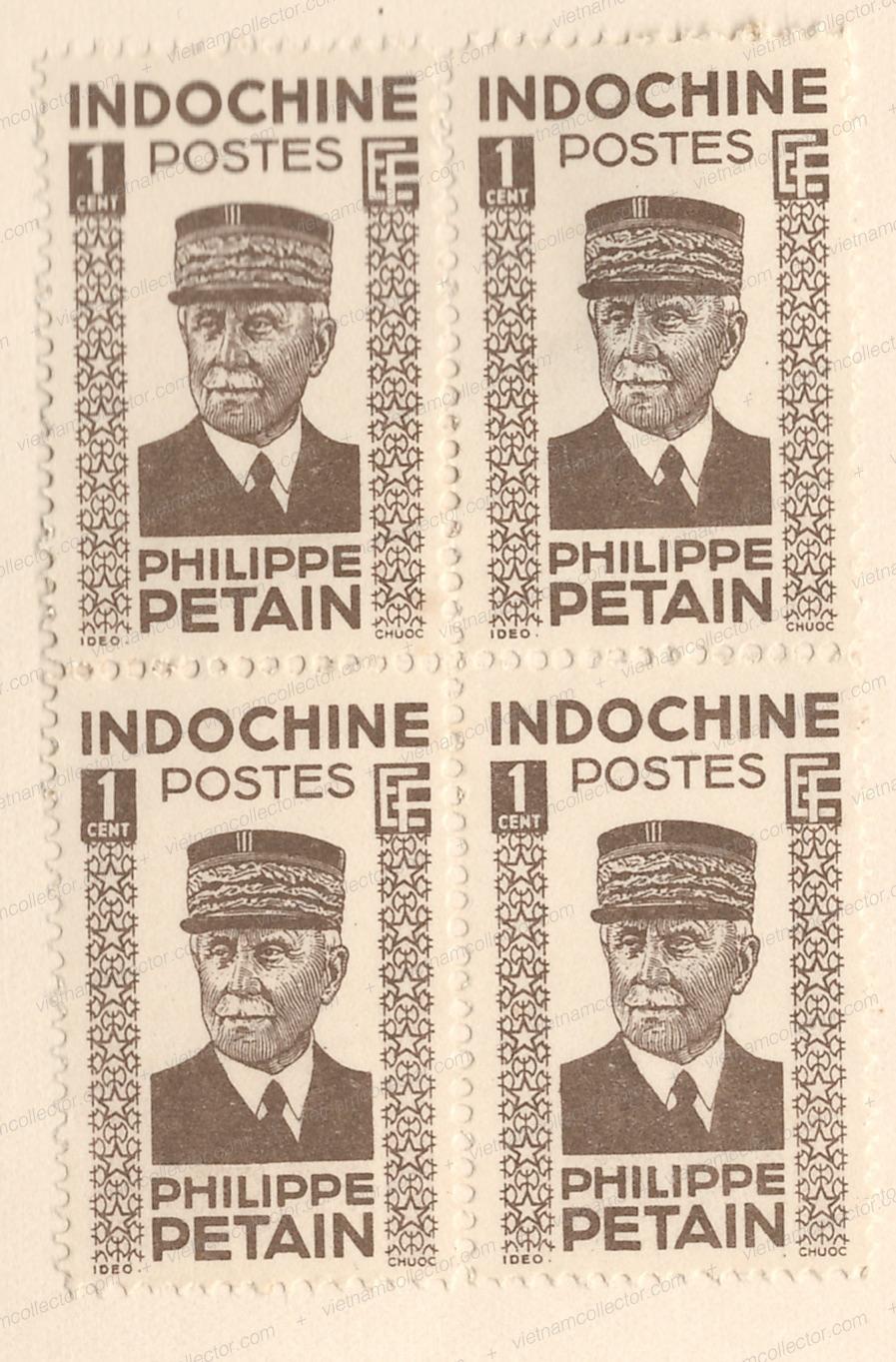
Mint 1 C stamp perforated 11.5:11.75 (not yet catalogued). Also not that the first line to the left in the hat is shortened.
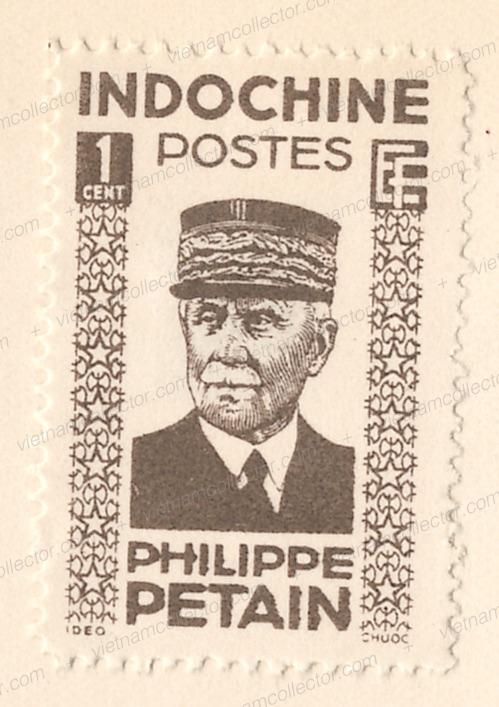
Cancelled to order block of four perforated 14:13.75 (not yet catalogued)
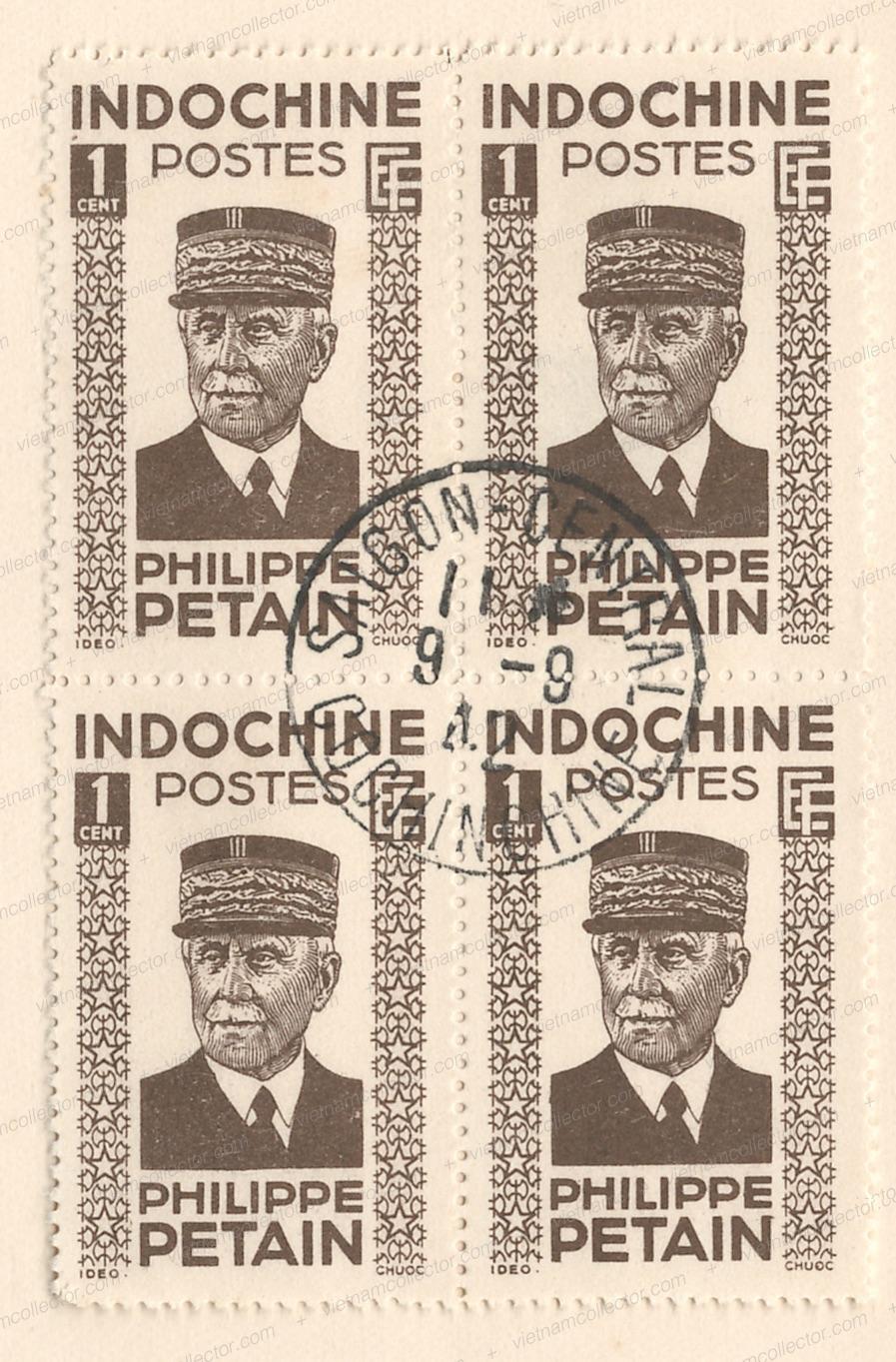
Postally used 1 C value perforated 11.5:11.75 (Not yet catalogued)
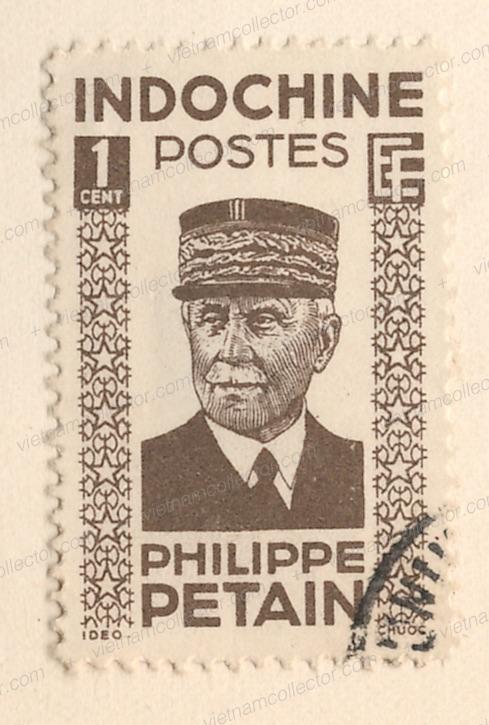
Postally used 1C value perforated 14
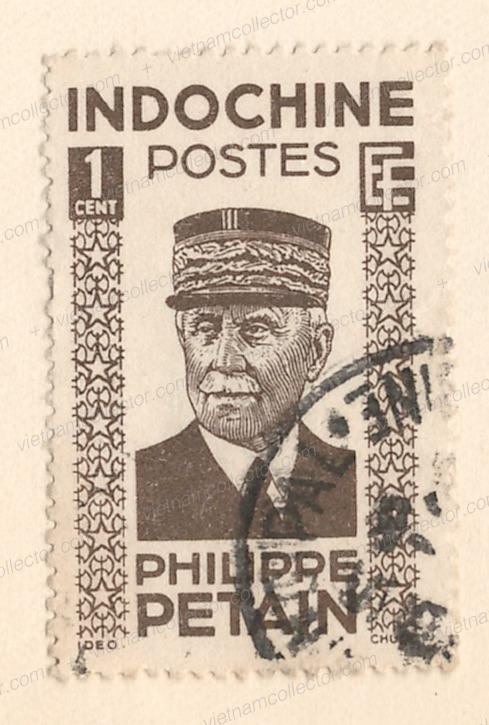
Postall yusuf 1 C stamp perforated 13.75:14 (Not yet catalogued)
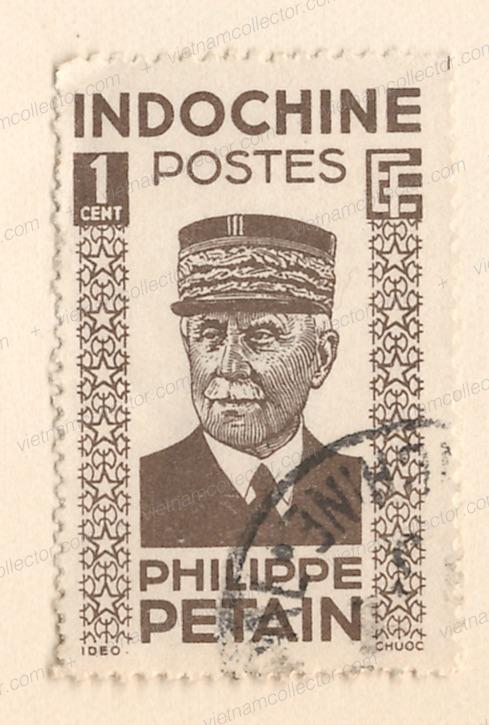
Postally used 1C stamp perforated 13.75 (Not yet catalogued)
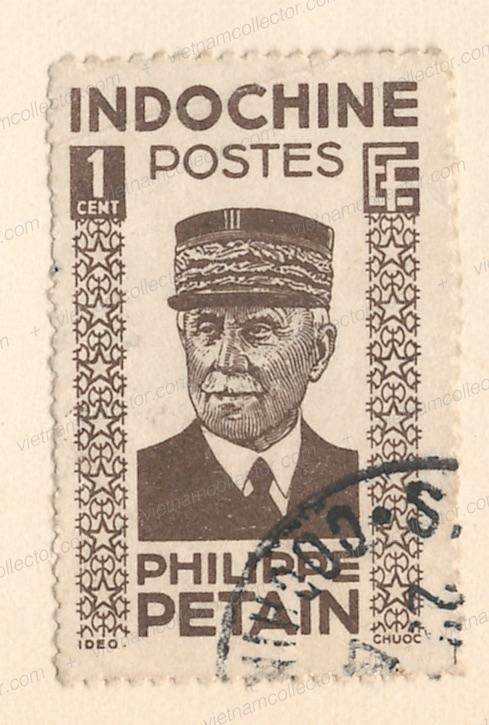
Postally used pair of the 1C value perforated 11.75 (Not yet catalogued)
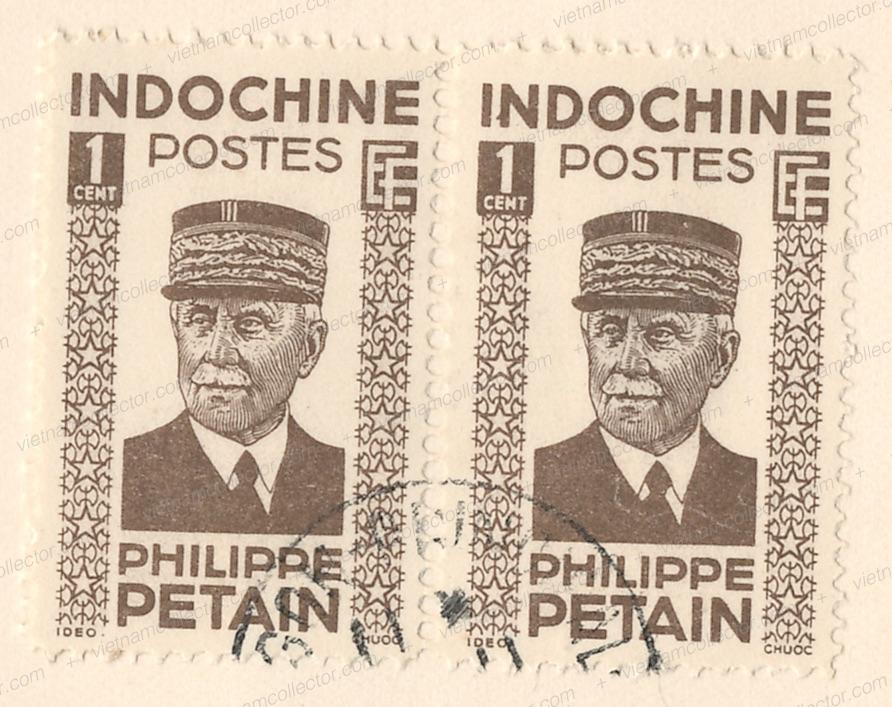
Block of six 1C stamps (Perf. 11.5) on piece cancelled with the rare octagonal small post office cancel.
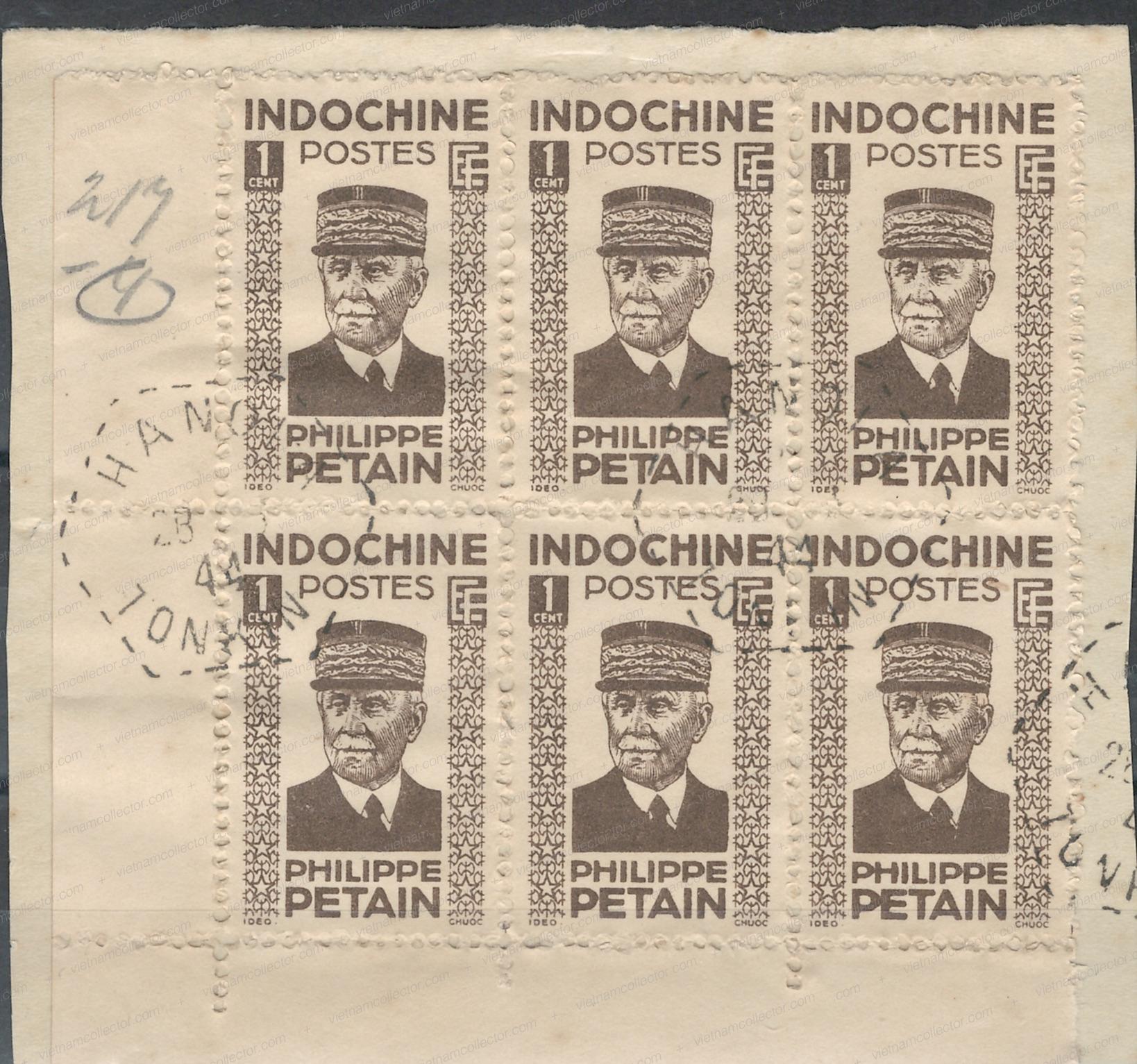
1C stamp cancelled on the First Day of Issue
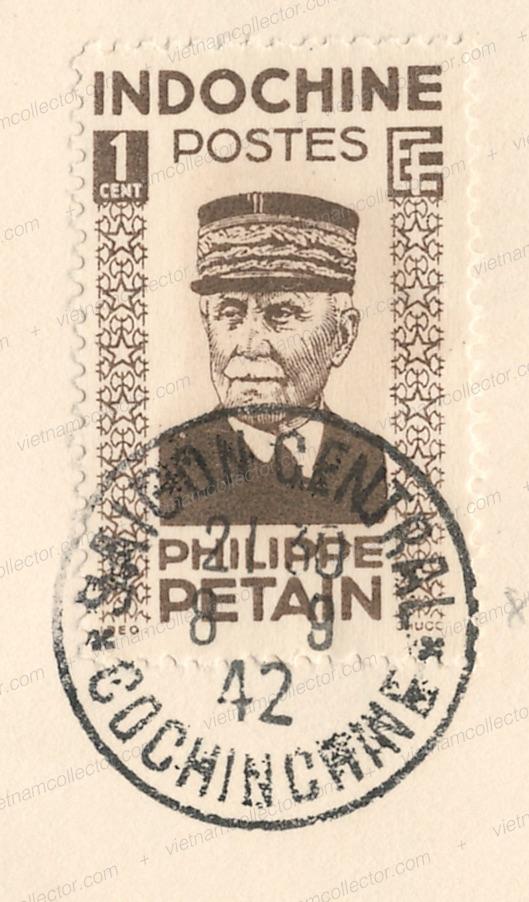
Mint block of four of the 3C value perforated 14:13.75 (not yet catalogued). Note that the bottom left stamp shows a plate error of “wart to the left of Petain’s nose”.
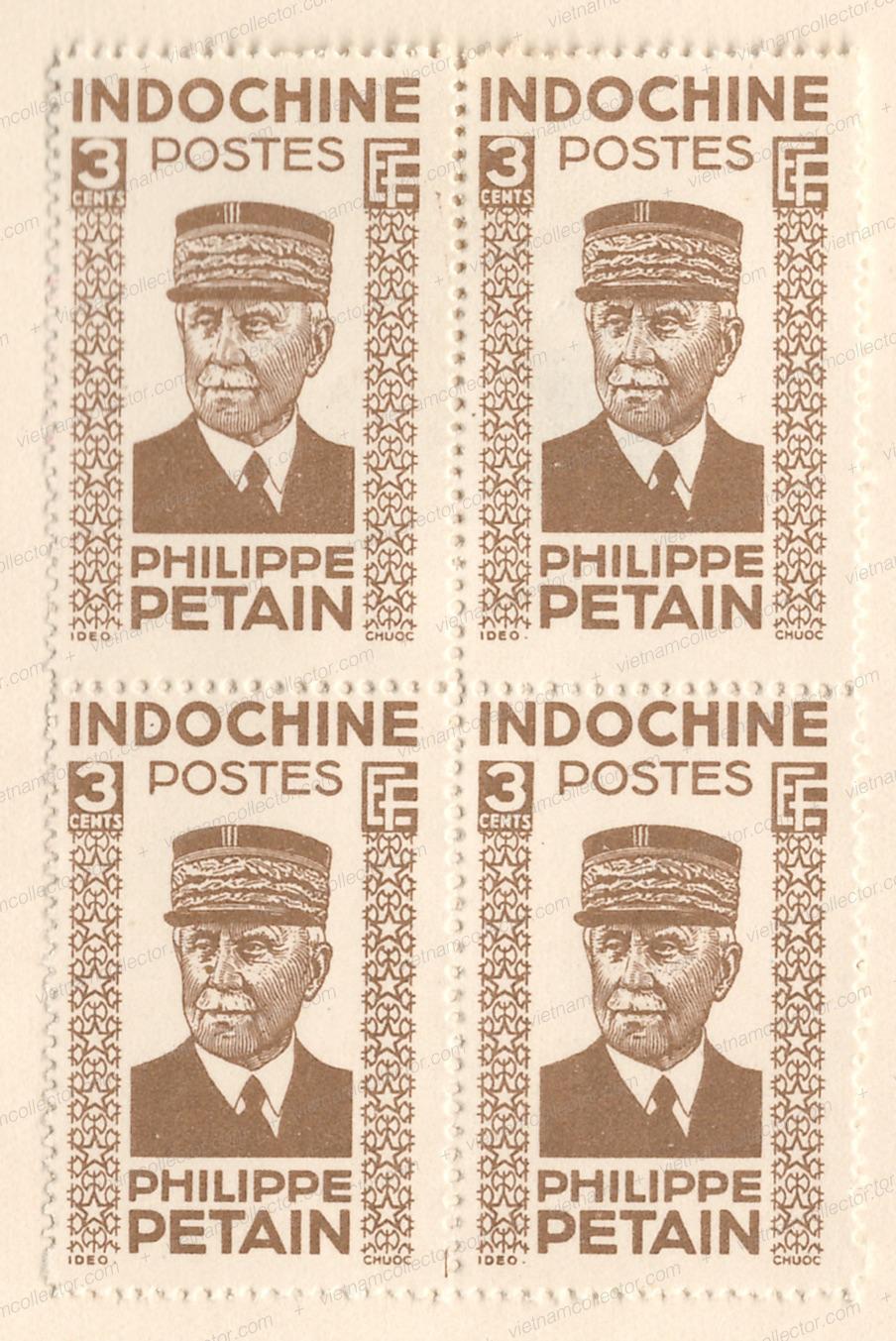
Mint 3C stamp of the 3C value perforated 11.75:13.75 (Not yet catalogued)
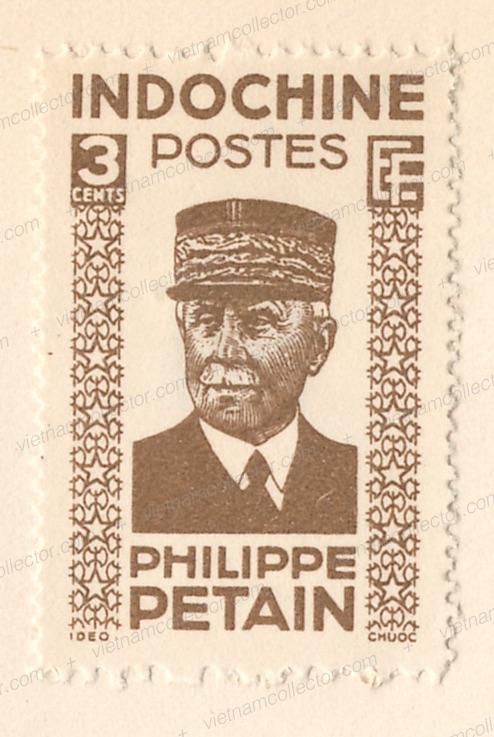
Mint 3C stamp of the 3C value perforated 11.5:14 (Not yet catalogued)
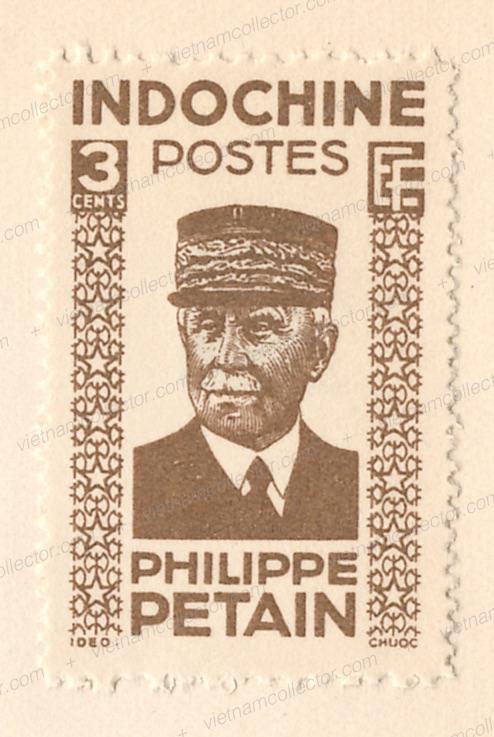
Mint pair of the 3C value perforated 11.5:14
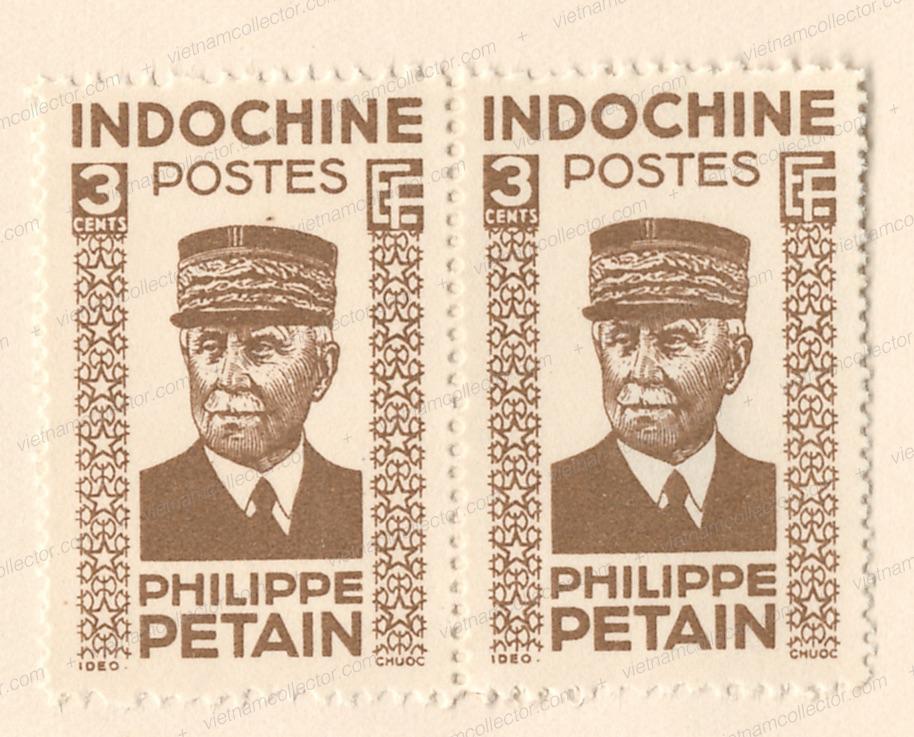
Cancelled to order block of four of the 3C value perforated 14:13.75 (not yet catalogued). Note that the 3 white lines in Petain’s hat are barely visible on the two right stamps.
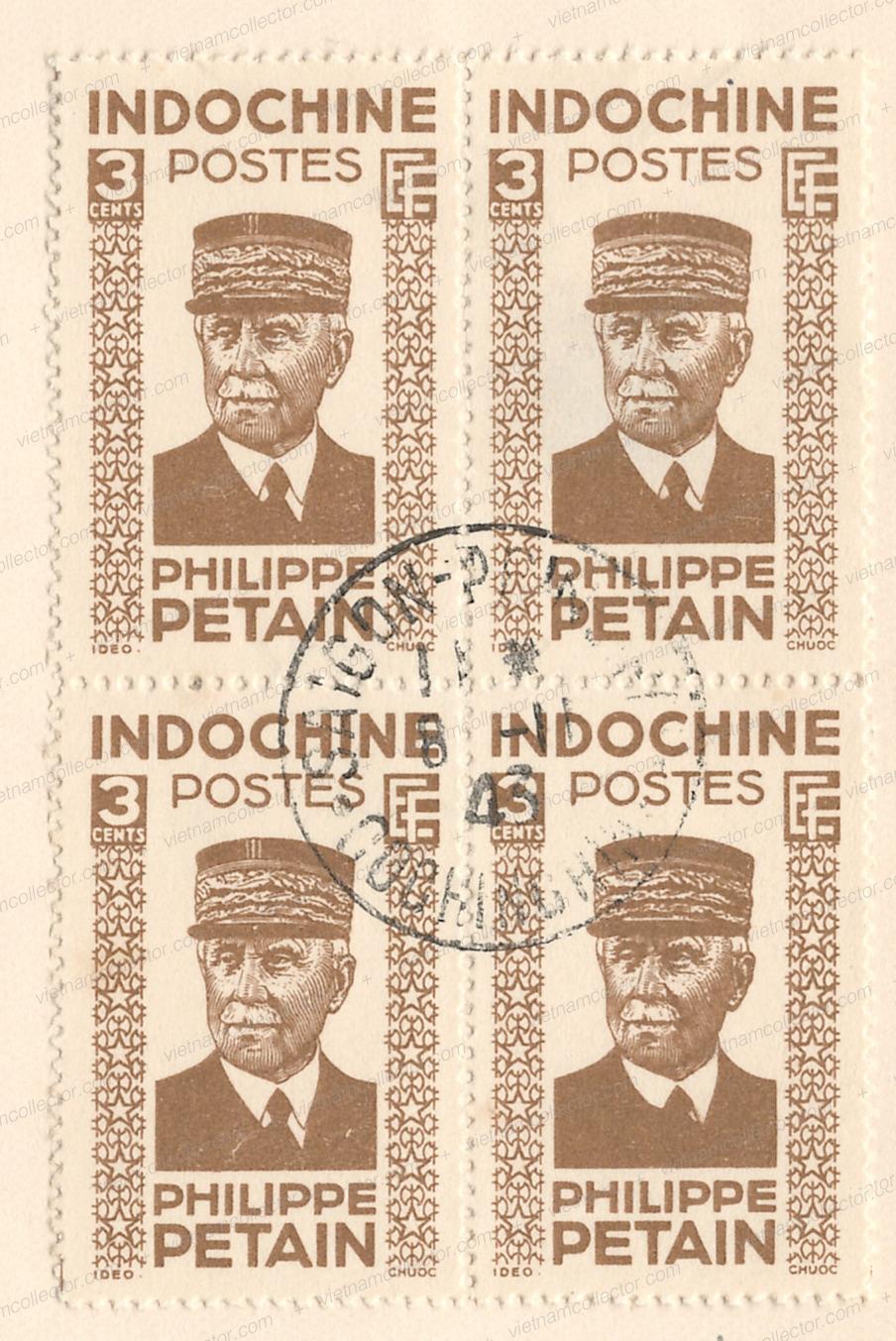
Postally used pair of the 3C stamp perforated 11.5:14. Note that both stamps show the variety of “Petain’s hat has only two instead of three white stripes”.
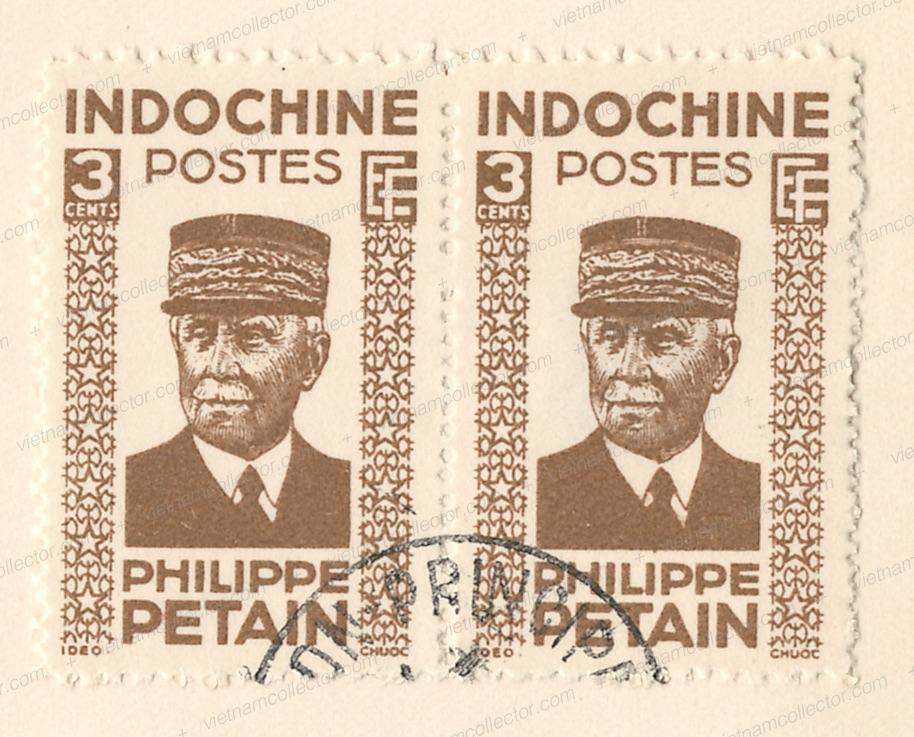
Postal yusuf 3V value perforated 13.75 (Not yet catalogued)
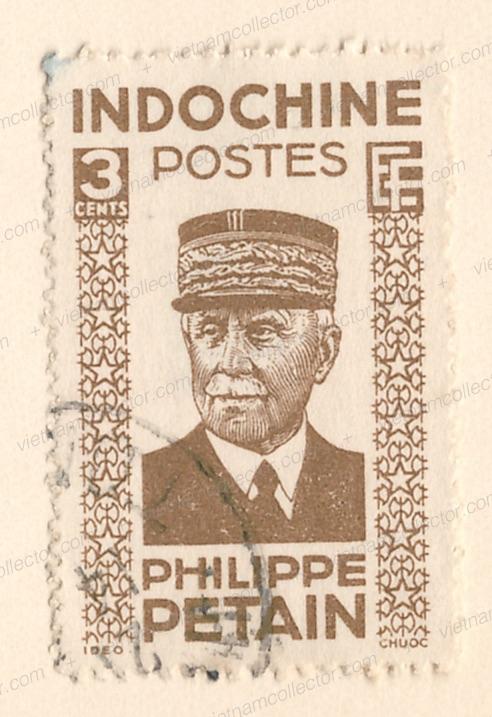
Postally used 3C stamp perforated 13.75:12 (Not yet catalogued)

Postally used 3C stamp perforated 11.75:13.5 (not yet catalogued)
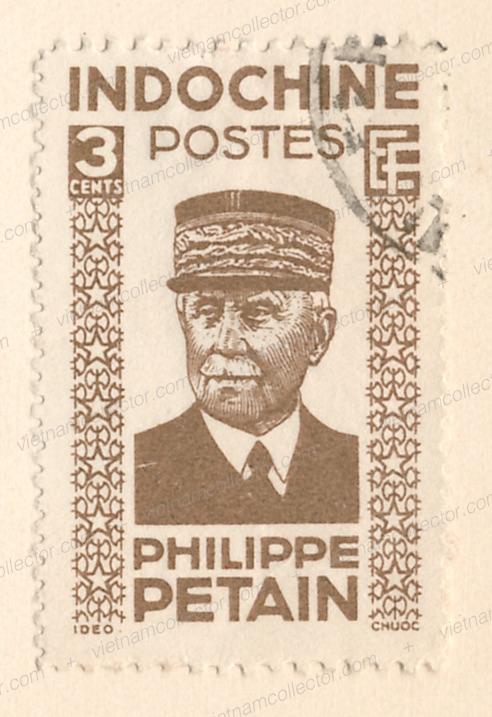
Mint block of four of the 6C value perforated 11.5
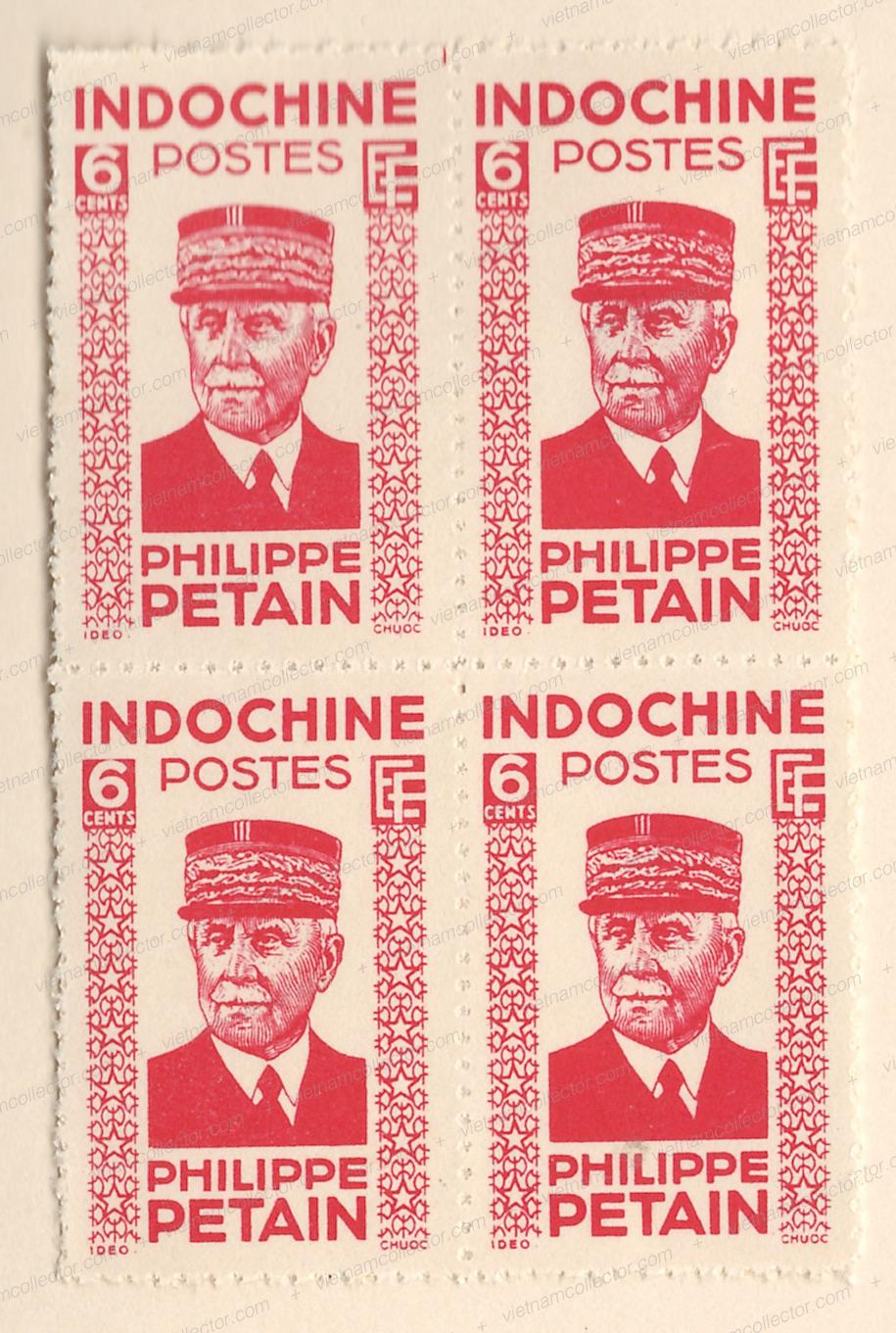
Cancelled to order block of four perforated 11.5. Note that the bottom right stamp shows the variety “Petain’s hat has only two instead of three stripes”.
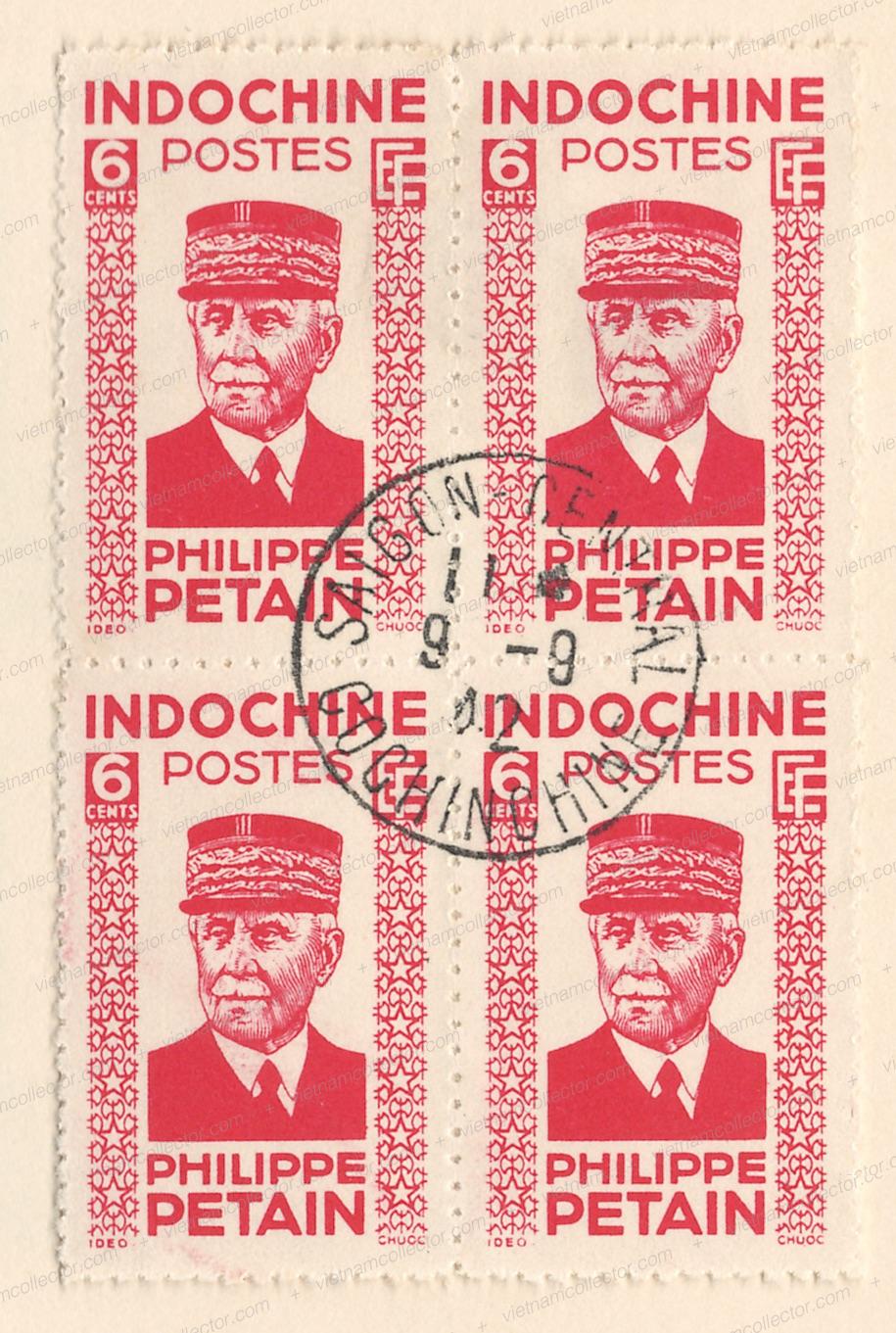
Postally cancelled 6C stamp perforated 11.75 (Not yet catalogued)
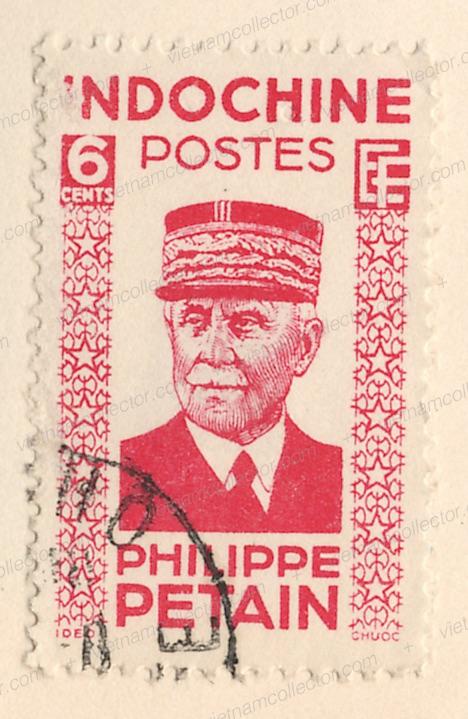
Postally used 6C stamp perforated 13.75 (Not yet catalogued)
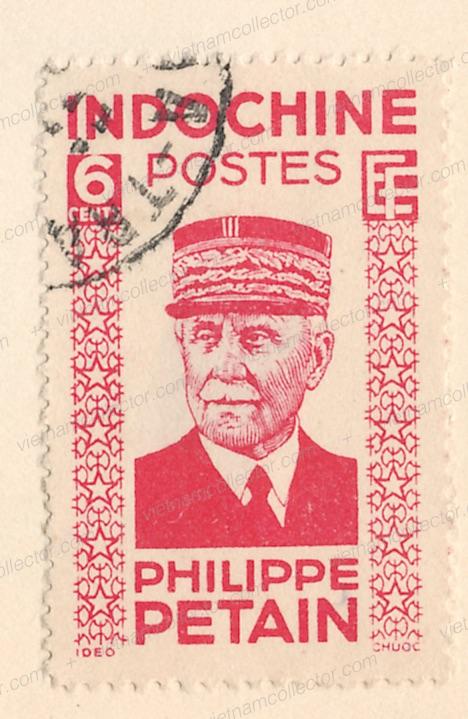
Postally used stamp with Vientiane, Laos cancel.
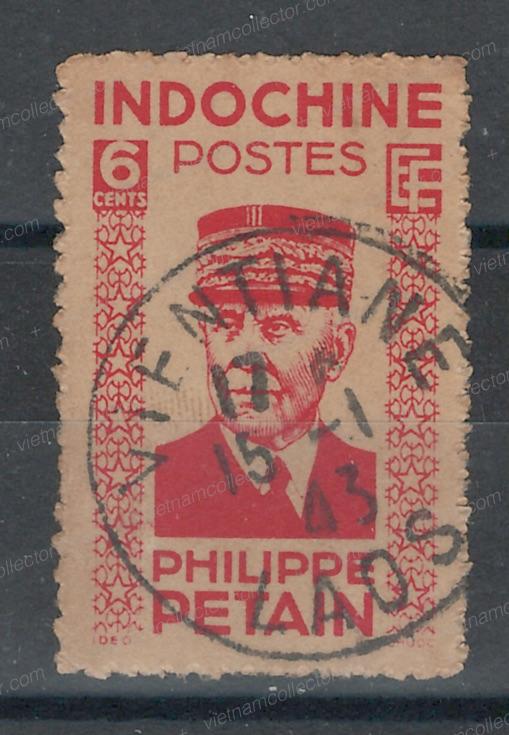
6C stamps featuring rare cancels from Banme and the rural cancel of Cai Ven.
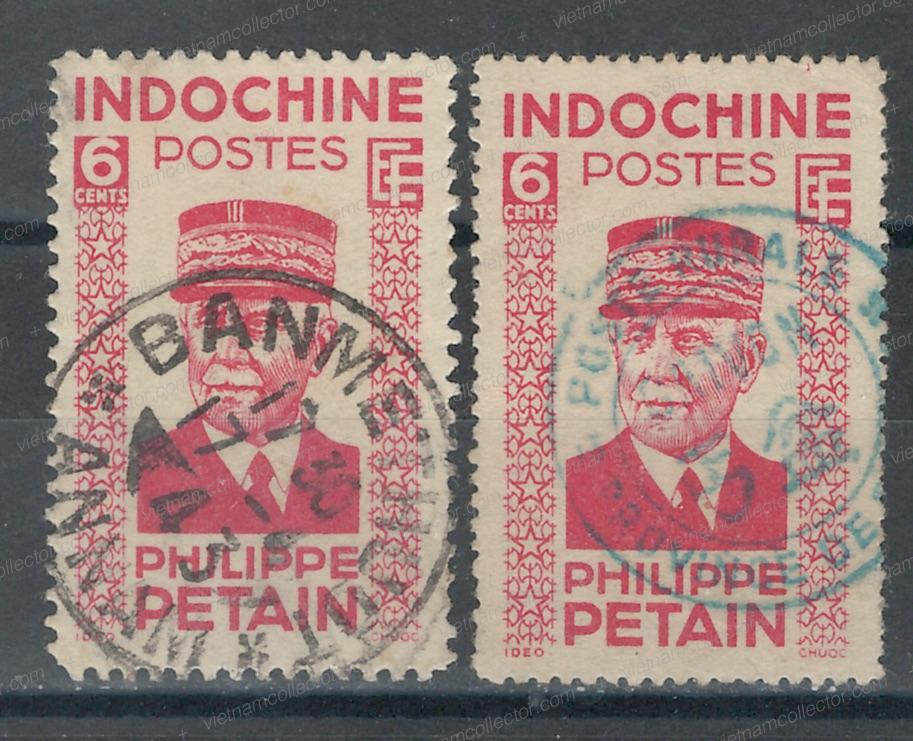
6C stamp featuring the First Day Cancel
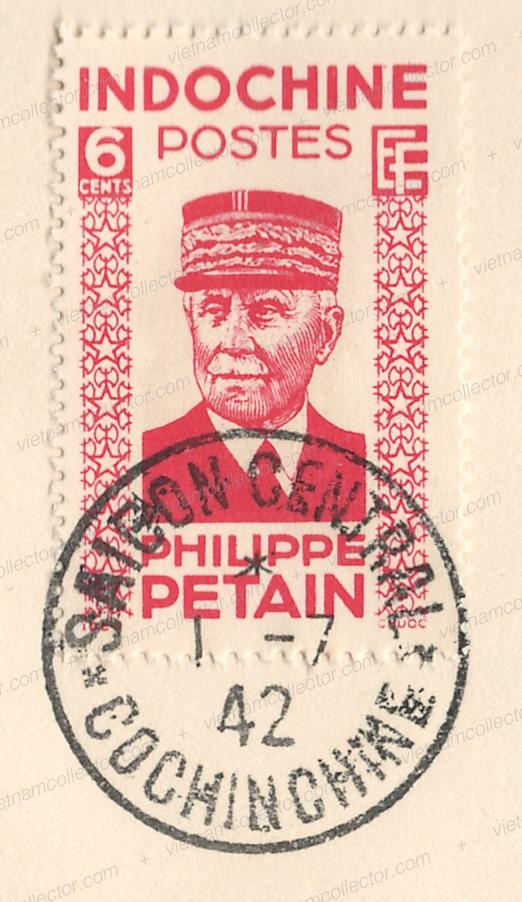
Mint block of four of the 10C value perforated 11.5. Note that the bottom two stamps only show two instead of three white lines in Petain’s hat.
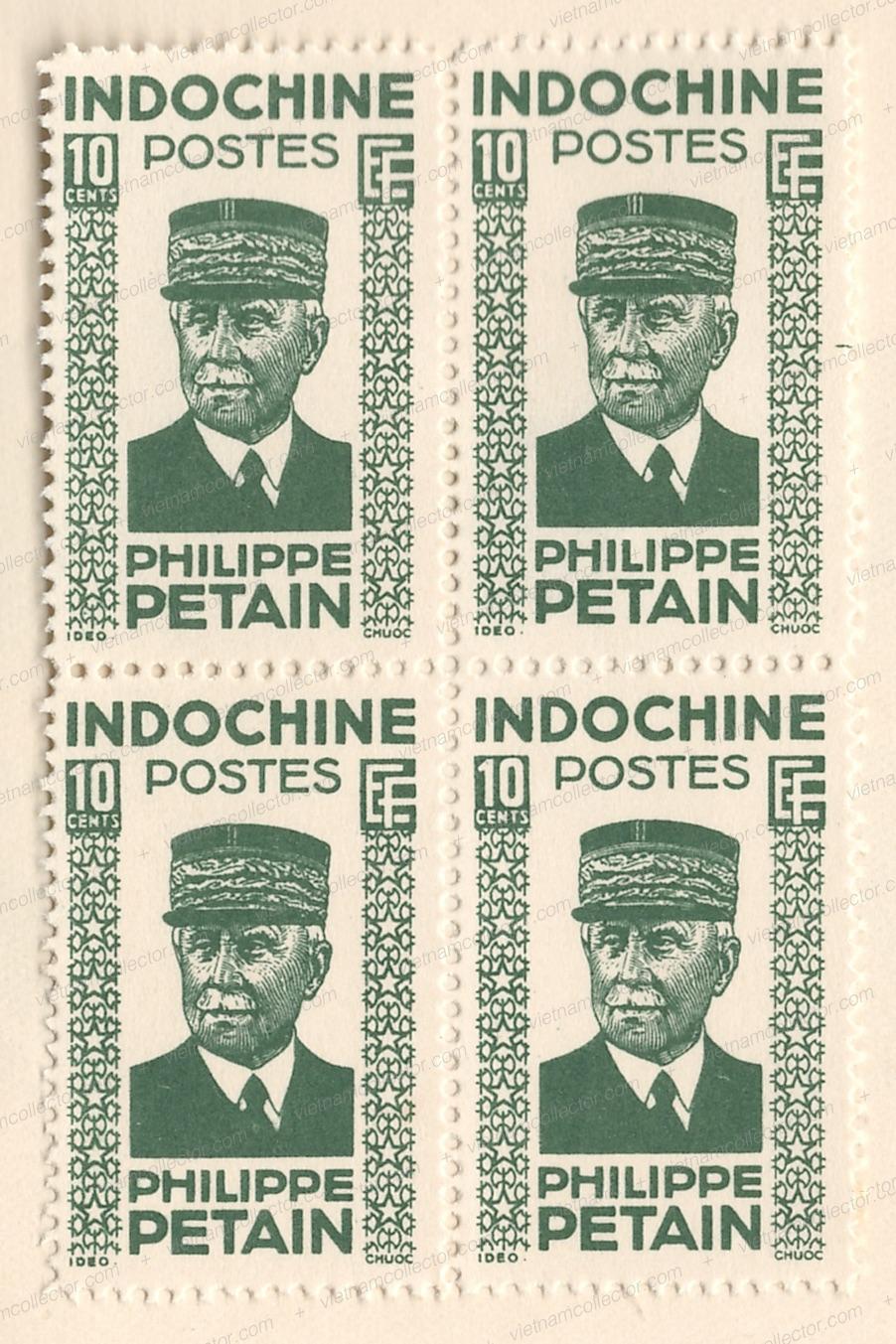
Mint 10C stamp perforated 11.5:11.75 (Not yet catalogued). Note that there are only two instead of three white lines in Petain’s hat.
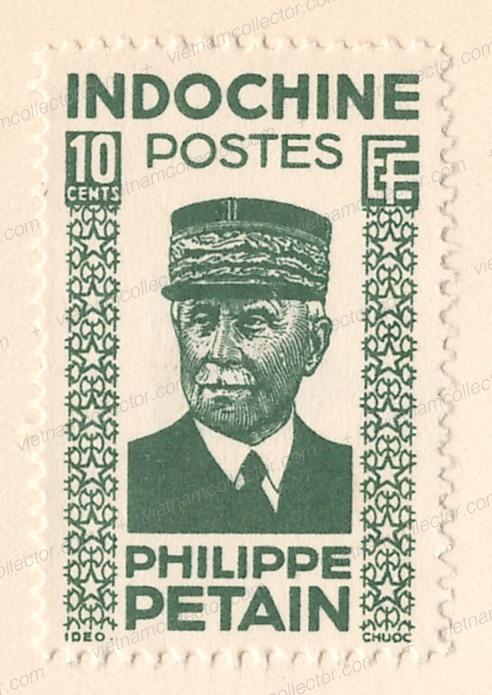
Detailed scan of the affected area.
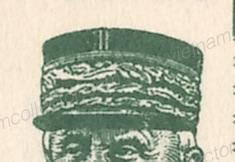
Mint pair of the 10C value perforated 11.5:12 (Not yet catalogued). Note that the right stamp only shows two instead of three white lines in Petain’s hat.
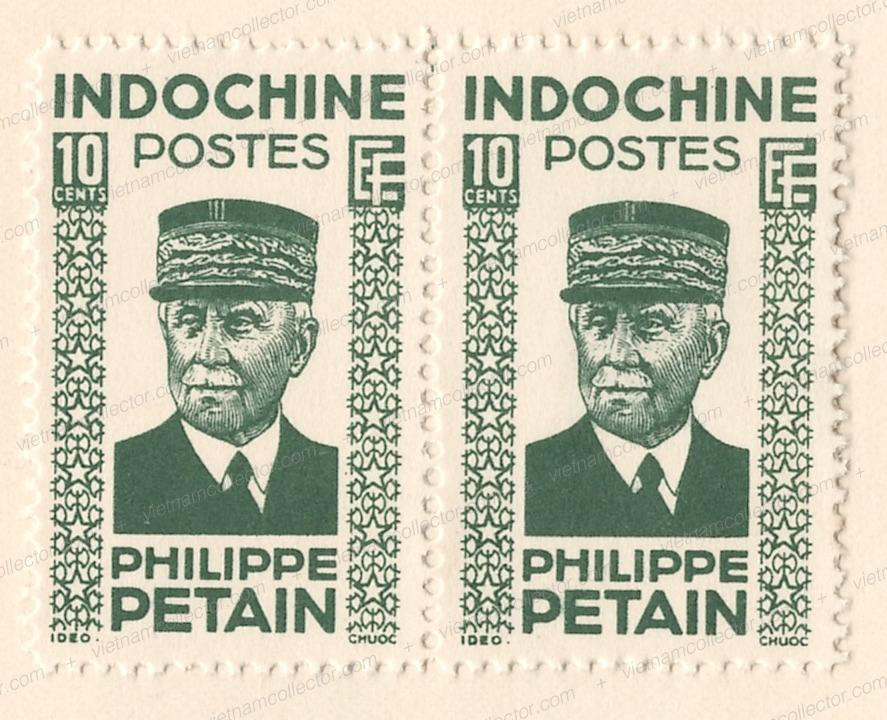
Cancelled to order block of four perforated 11.5
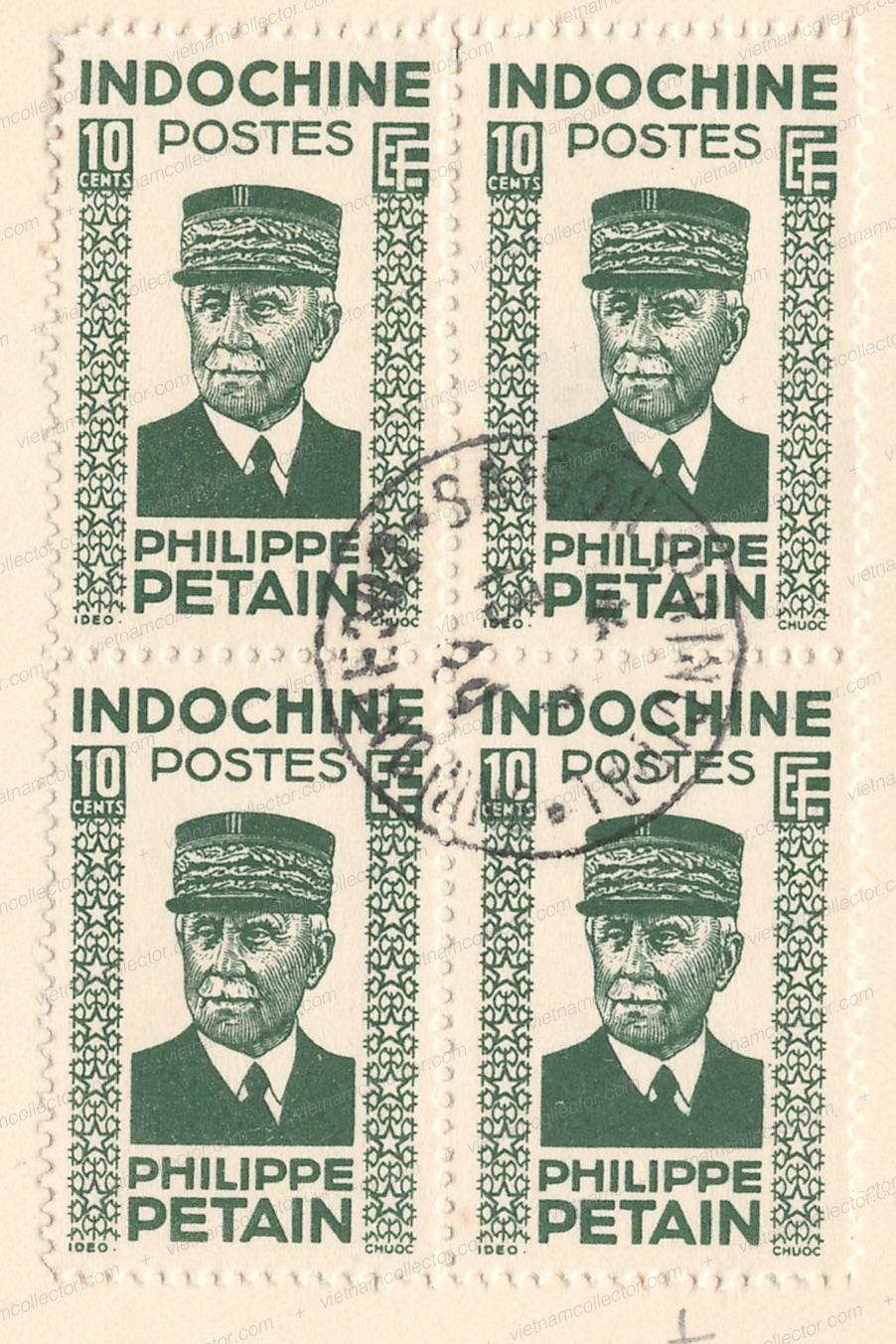
Postally used 10C stamp perforated 11.75 (not yet catalogued)
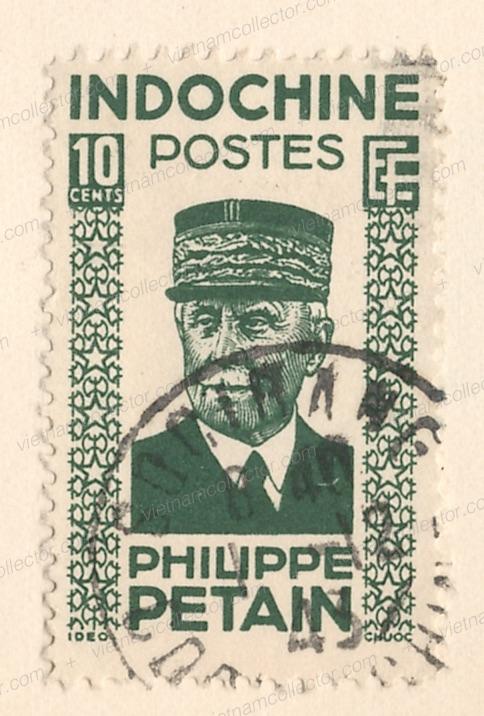
Postally used 10C stamp perforated 12 (not yet catalogued)
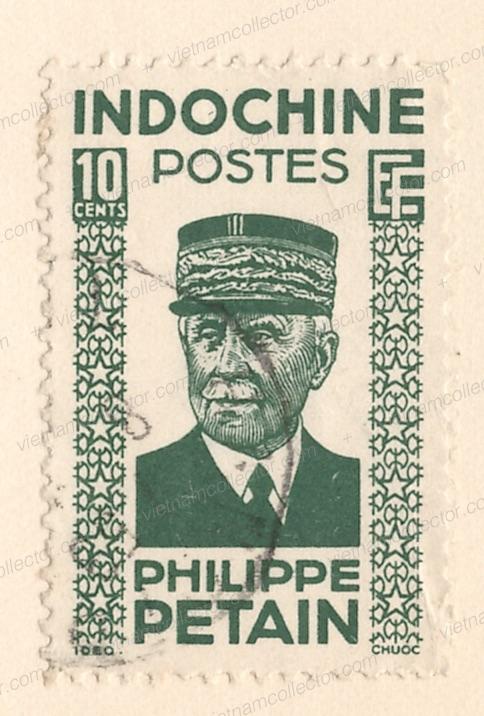
Postally used 10C stamp perforated 12.5:11.75 (Not yet catalogued)

Postally used pair f the 10C stamp perforated 12.5 (Not yet catalogued)
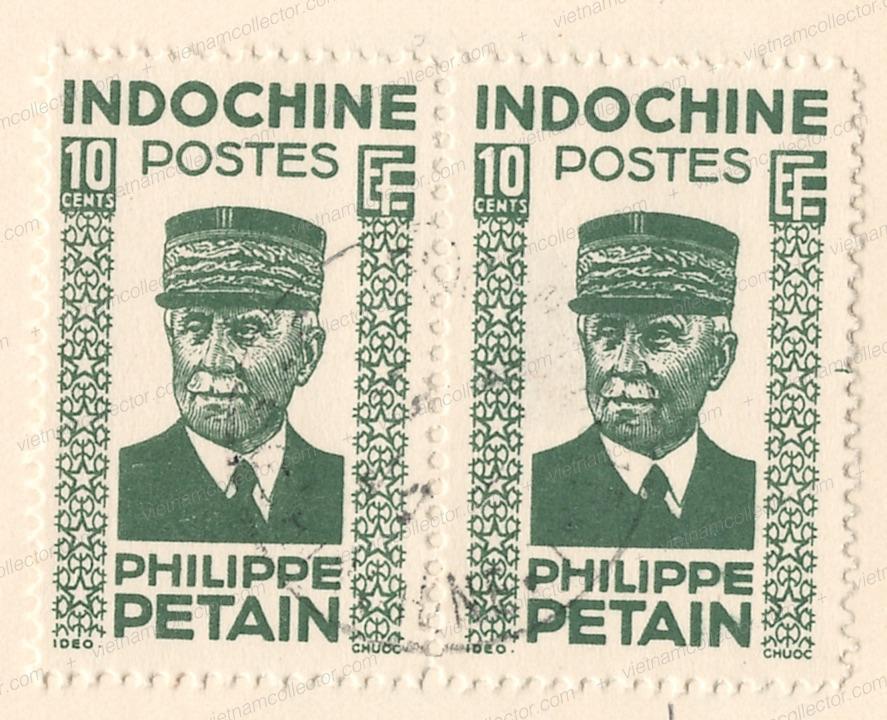
Criminals produced counterfeit stamps of the higher nominals (6C 10C and 40C) to defraud the postal system. Most of these counterfeit stamps were postally used without being recognized. This meant that most samples were thrown away making these counterfeits a scarce item today. Here is a scan that shows the counterfeit on the left and a genuine stamp on the right. The three biggest “tells” are:
Stamp color is olive green instead of green
“S of POSTES slightly slanted to the right” and
“vertical space between the two bars of EF is greater”
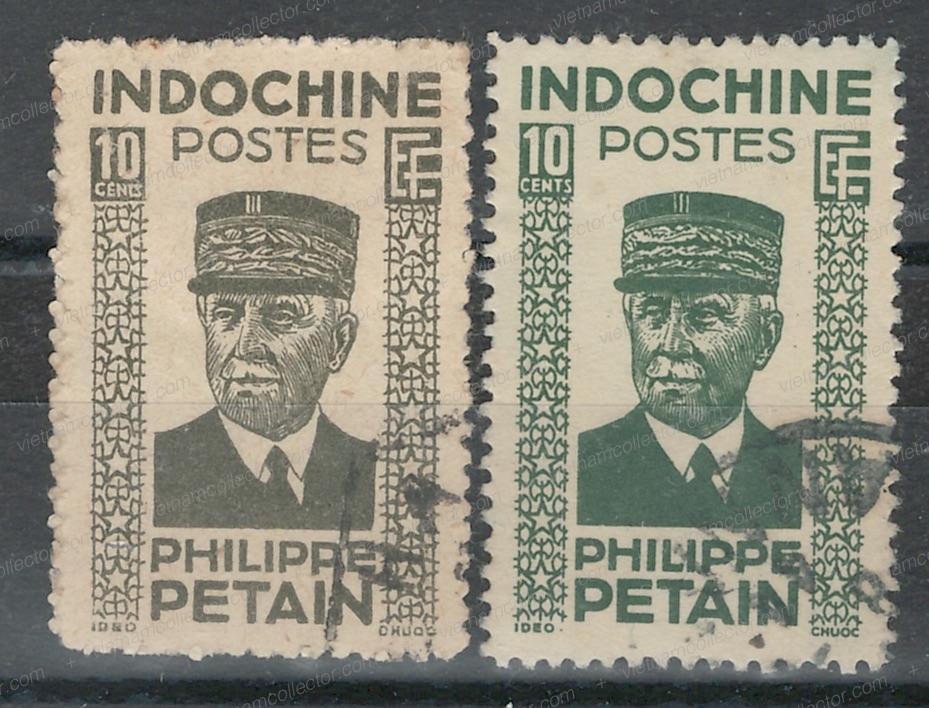
Detailed scan of the affected areas:

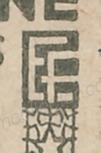
Mint block of 40C in blue color perforated 11.5

Complete sheet (50) of the 40C Petain stamp in the blue color.
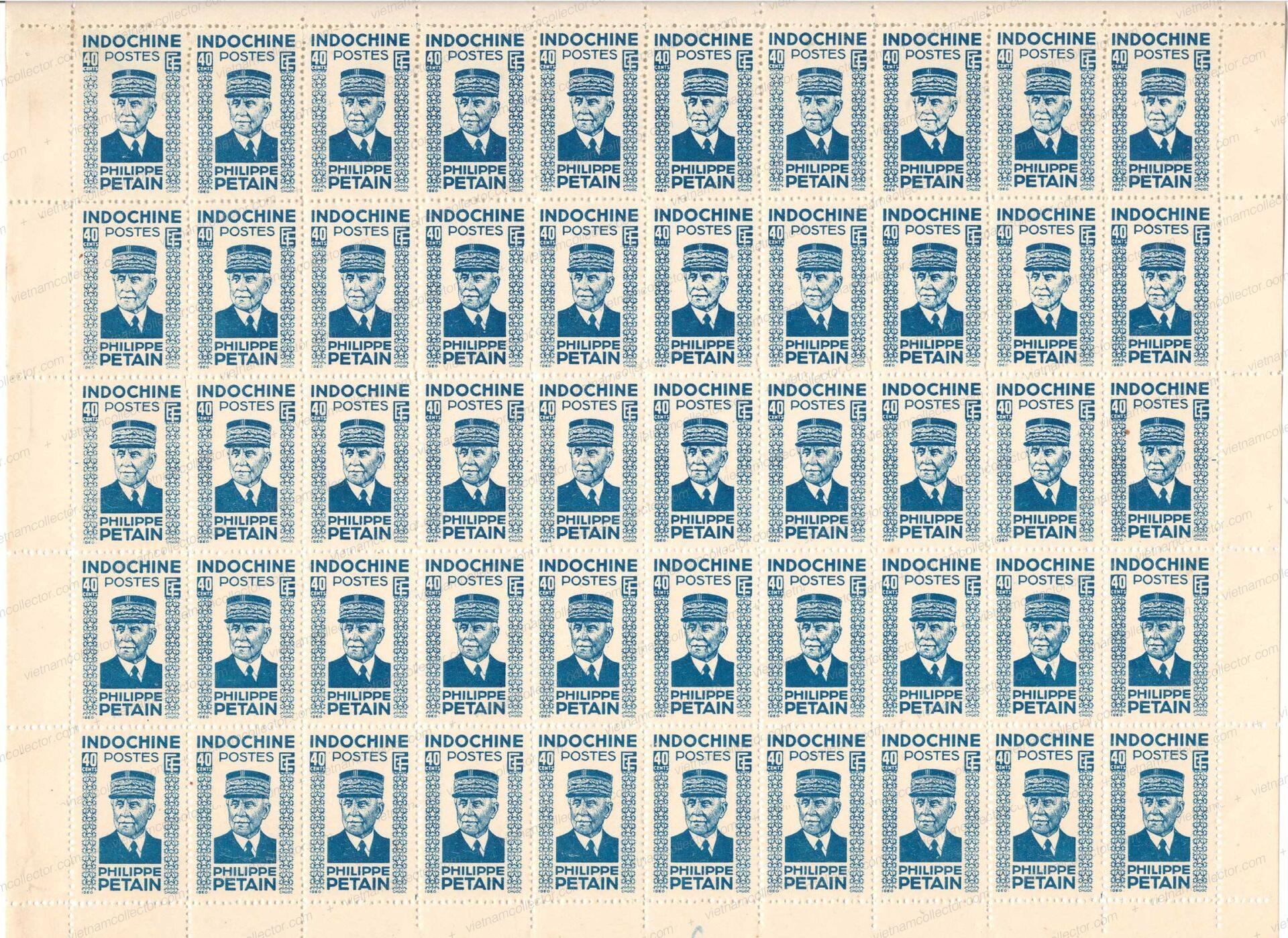
Cancelled to order block of four of the 40C stamp perforated 11.5
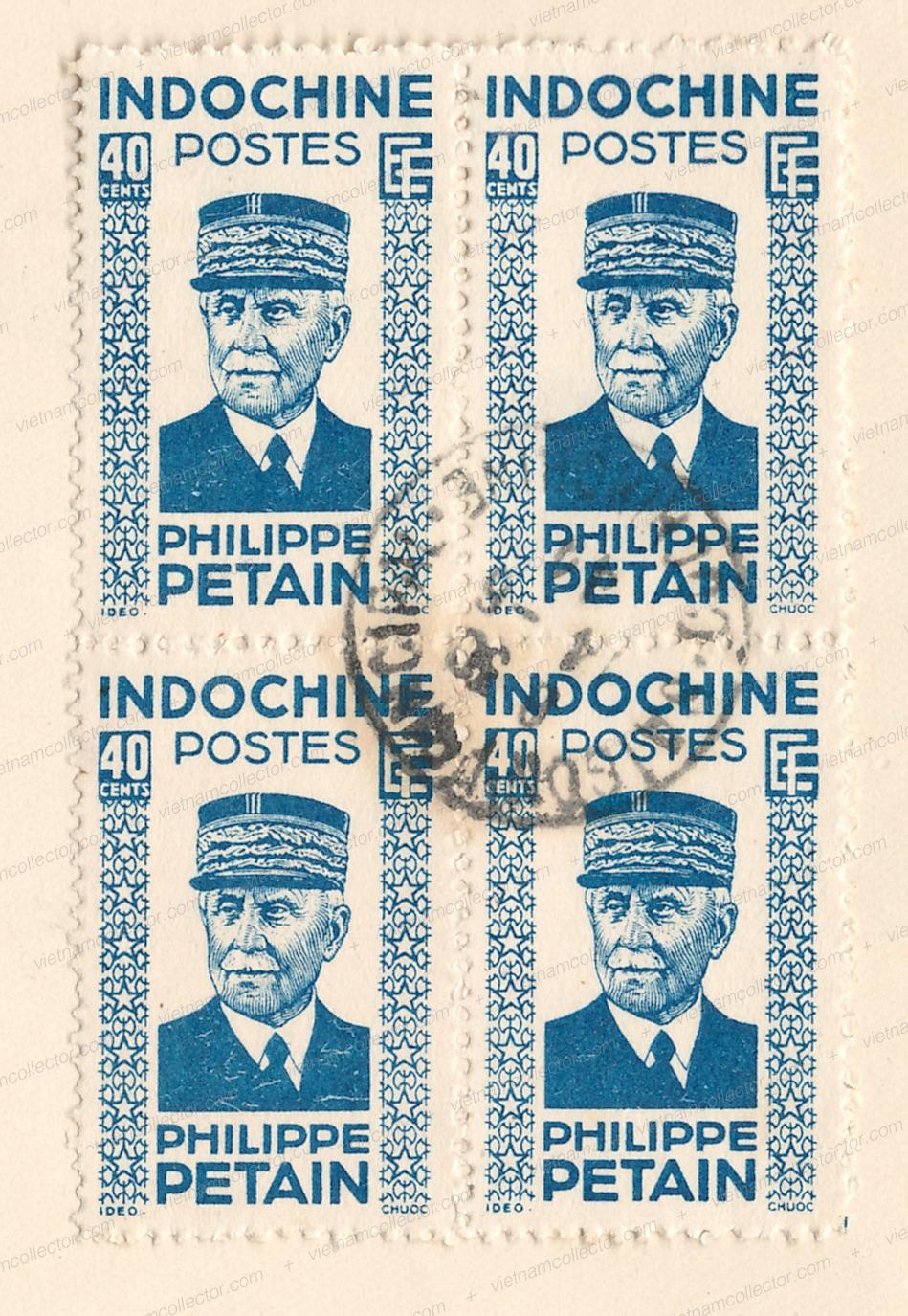
Postally used stamp in blue color and perforated 11.75:11.5 (Not yet catalogued)
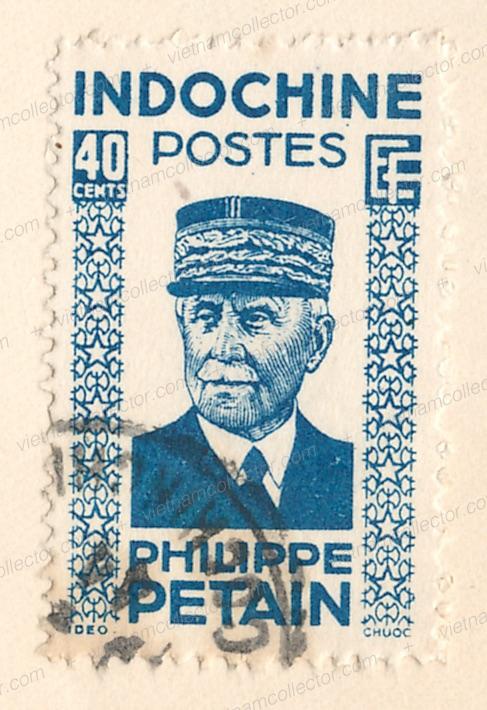
Postally used pair in blue color perforated 11.5:11.25 (Not yet catalogued)
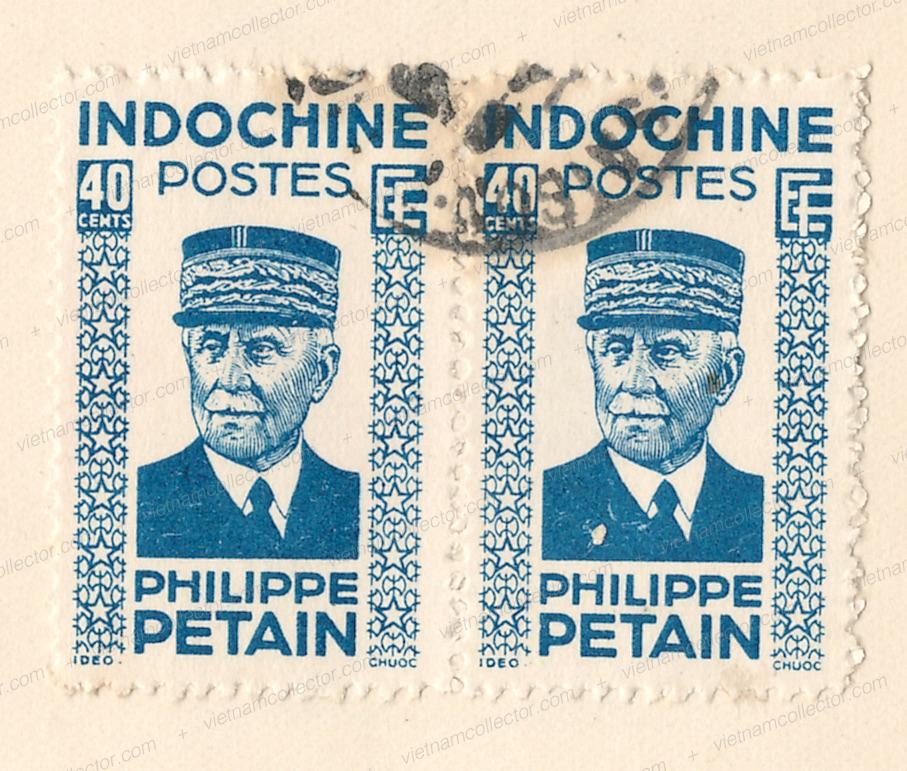
There is also a color variety that has not been reported by the catalogue yet (dark grey blue 31-2-7 according to the Michel Color Guide).
Here is a mint block of four in dark grey blue perforated 11.5
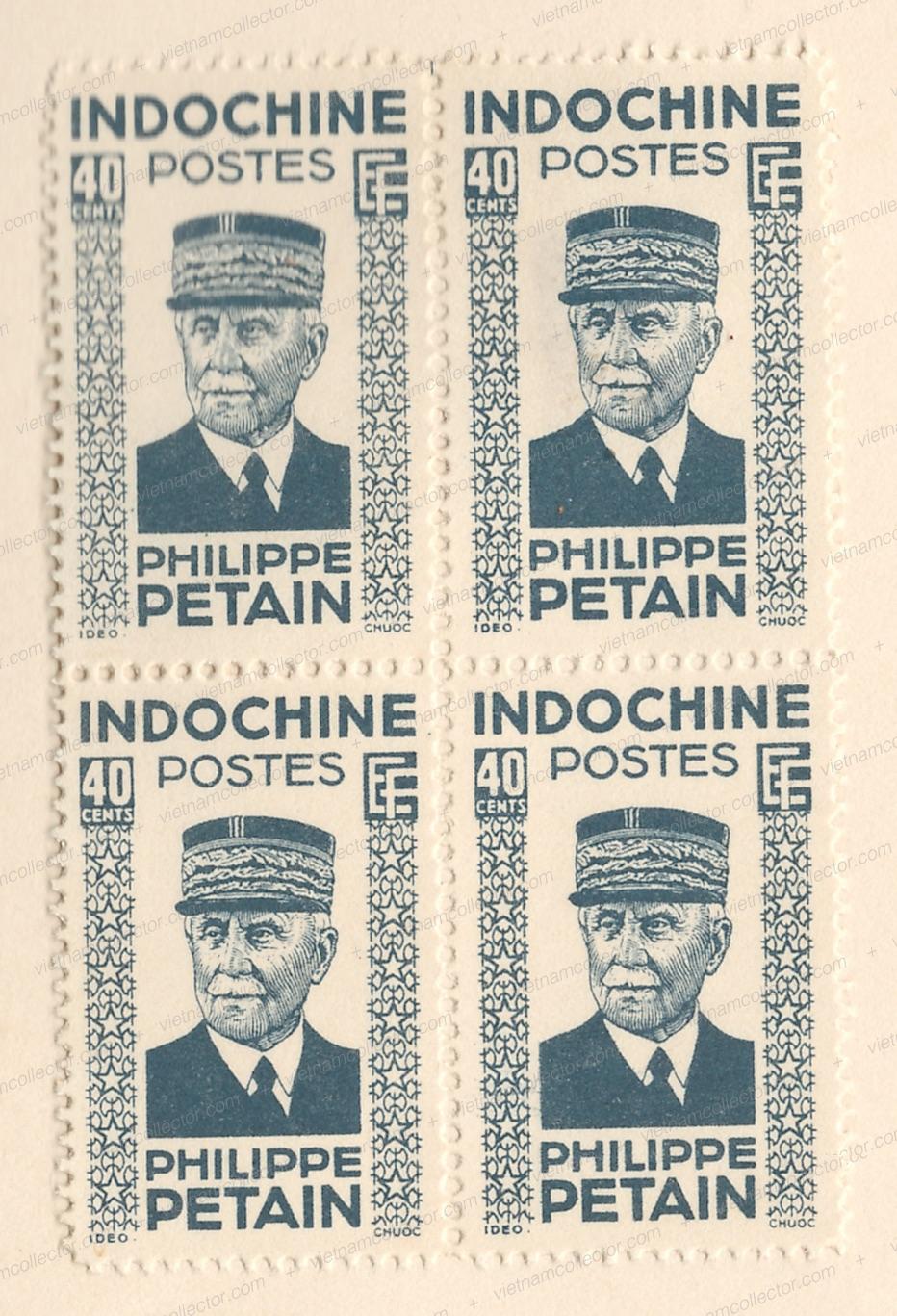
Cancelled to order of the 40C value in dark-grey-blue color and perforated 11.5
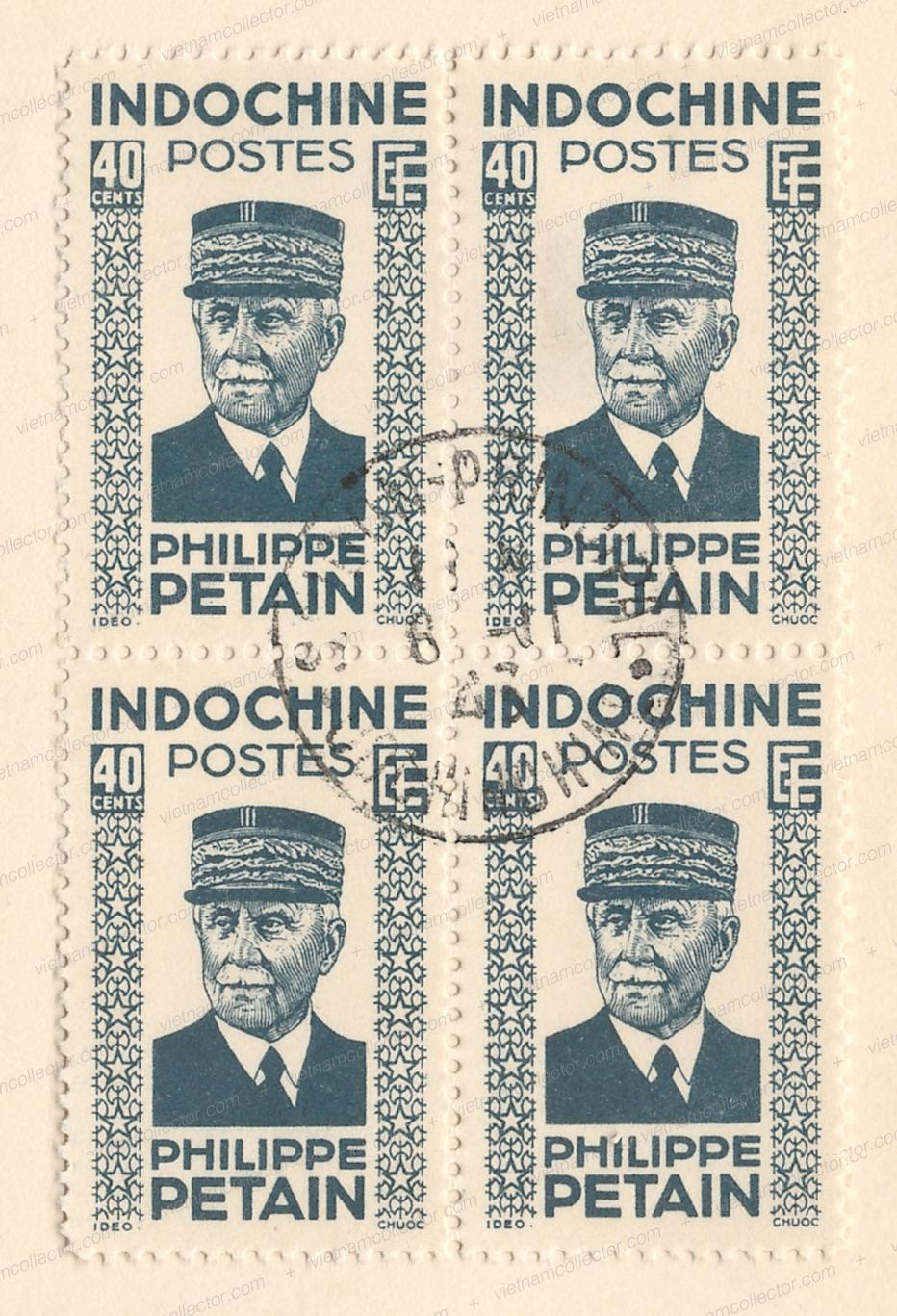
Mint stamp in dark-grey-blue color and perforated 11.5:11.75 (Not yet catalogued)
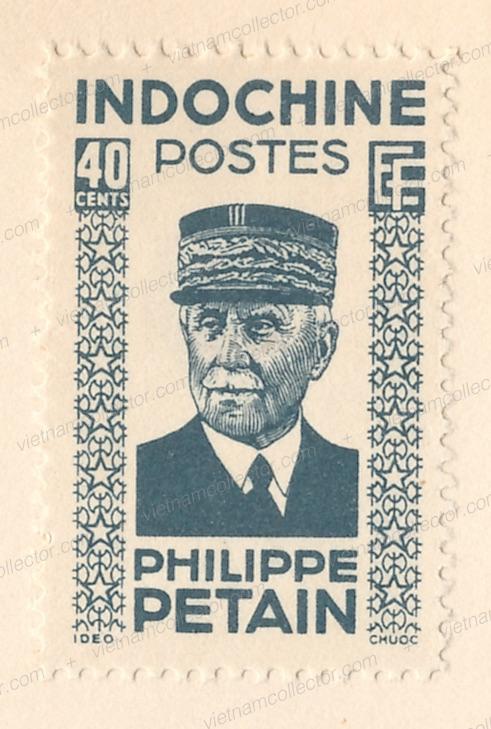
Mint pair in the dark.grey-blue color perforated 11.75 (Not yet catalogued)
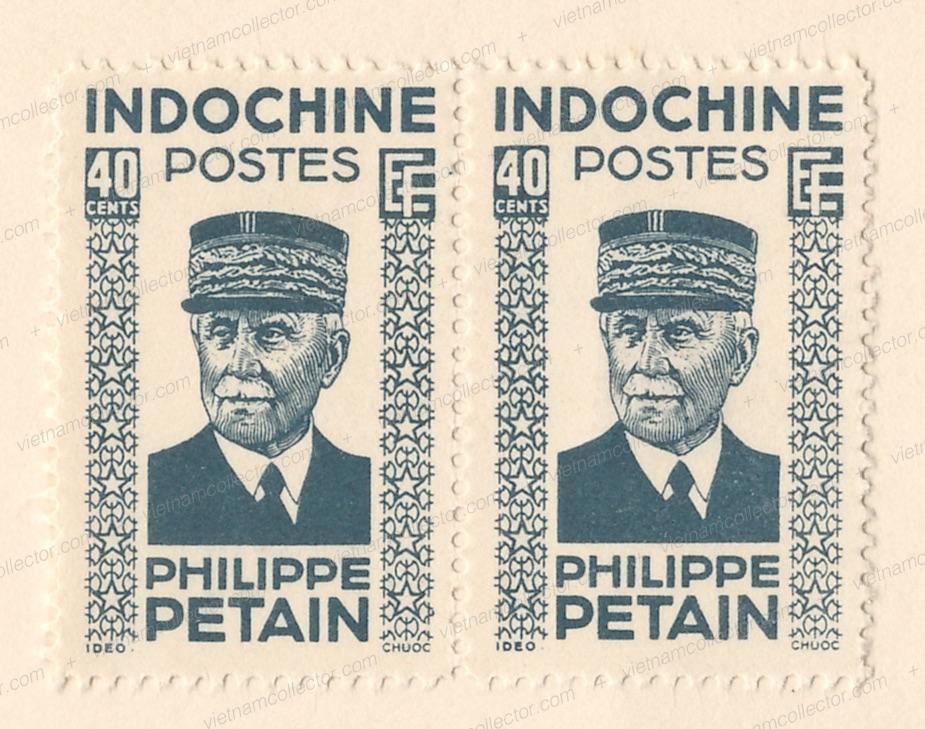
Postally used stamp in dark-grey-blue color and perforated 11.5:11.75 (Not yet catalogued)

Postally used pair in the dark-grey-blue color and perforated 11.75 (Not yet catalogued)
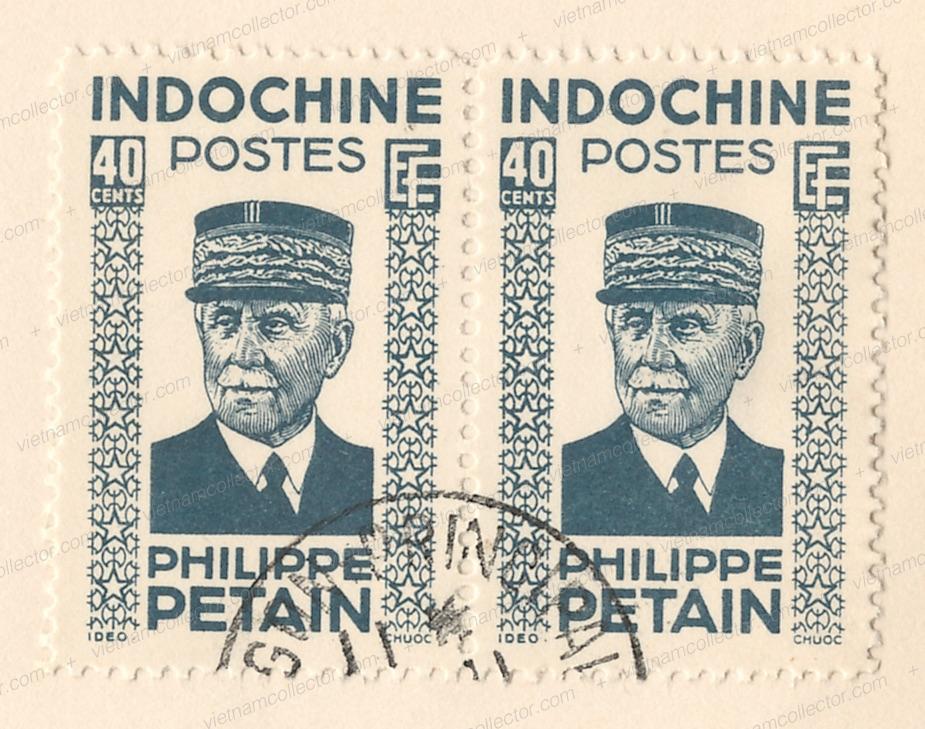
Here is a cancelled to order stamp in dark-grey-blue color that purports to carry a First Day Cancel. The cancellation date is January 25th, 1943 while Michel reports the issuing date as January 15th, 1943 for the blue green stamp and April 1st, 1944 for the blue stamp. It is not clear which date is correct. What is clear though os that the dark.grey-blue color variety was issued around the same time as the blue green variety. If you have any insight into this matter please contact the editor using the communication feature of this website.
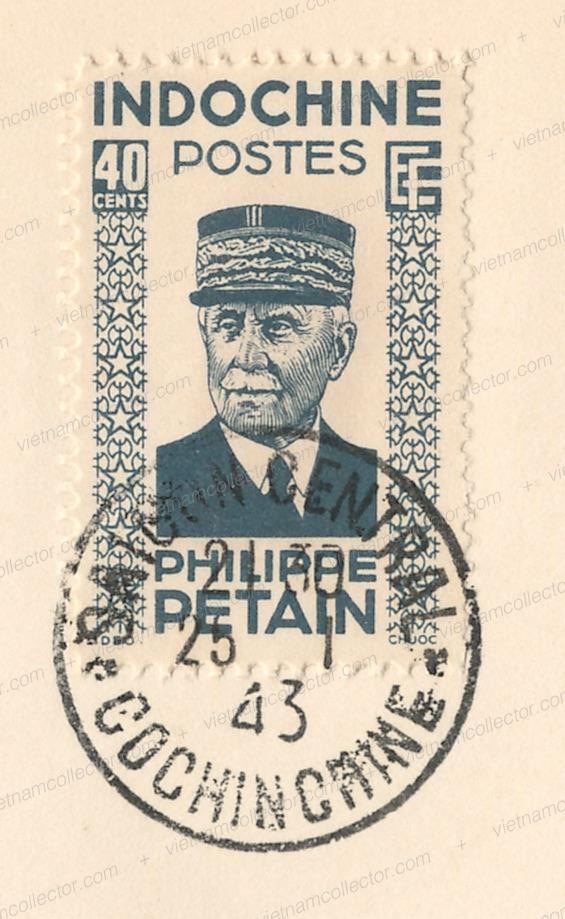
These stamps were not officially released imperforate however some imperforate specimens have come to market. Here are there imperforate 1C and 6C values.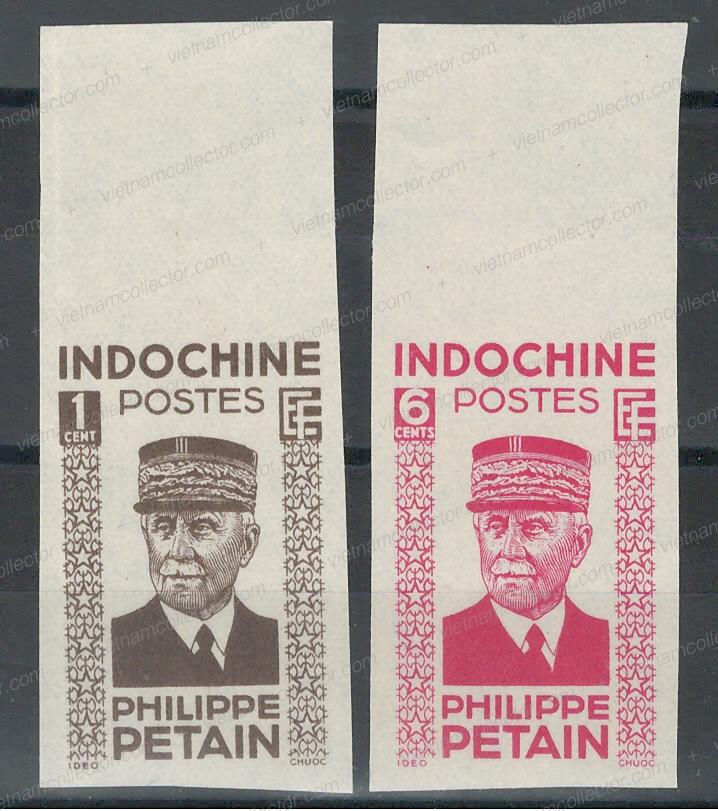
In order to protect postage stamps from theft large corporations perforated stamps inside the company with a perforation that displayed the initial of the company. By design these stamps should only get to market used once they were sent out by the originating company. Mint stamps are therefore unusual as they could only come to market if they were either purchased or stolen from the company. As a result mint stamps with perfins are very rare. Here are mint blocks of four of the 1C and 3C values showing the “BI” that was used by the Bank of Indochina.

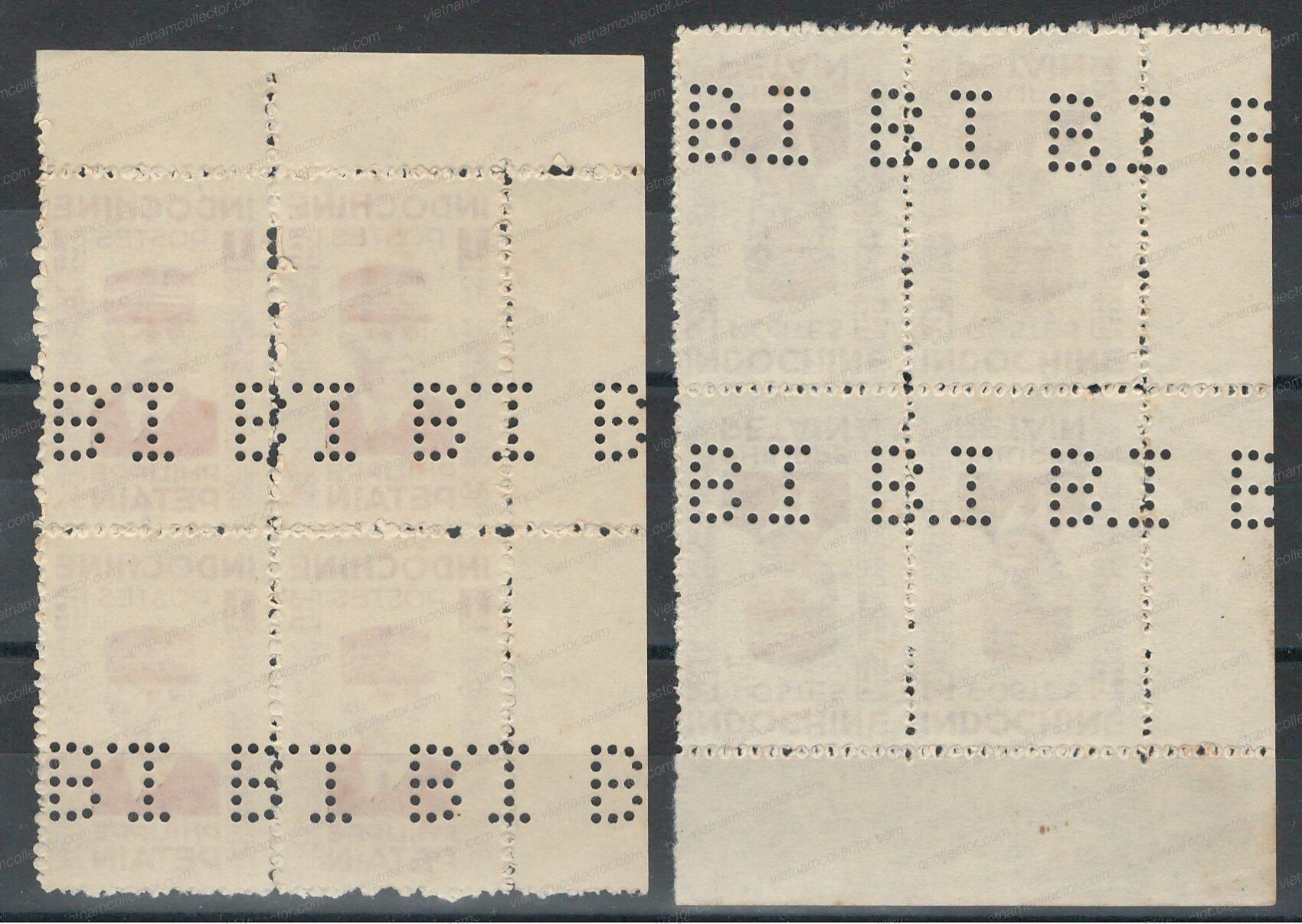
Single franking of the 3C value on a domestic folded letter (printed matter?) sent in June of 1944, during the Japanese Occupation from Cholon to Sadec. A Daguin type propaganda cancel stating “Union and Discipline Necessary Conditions of Unity” was applied on front. Circular Governmental Seal on front.
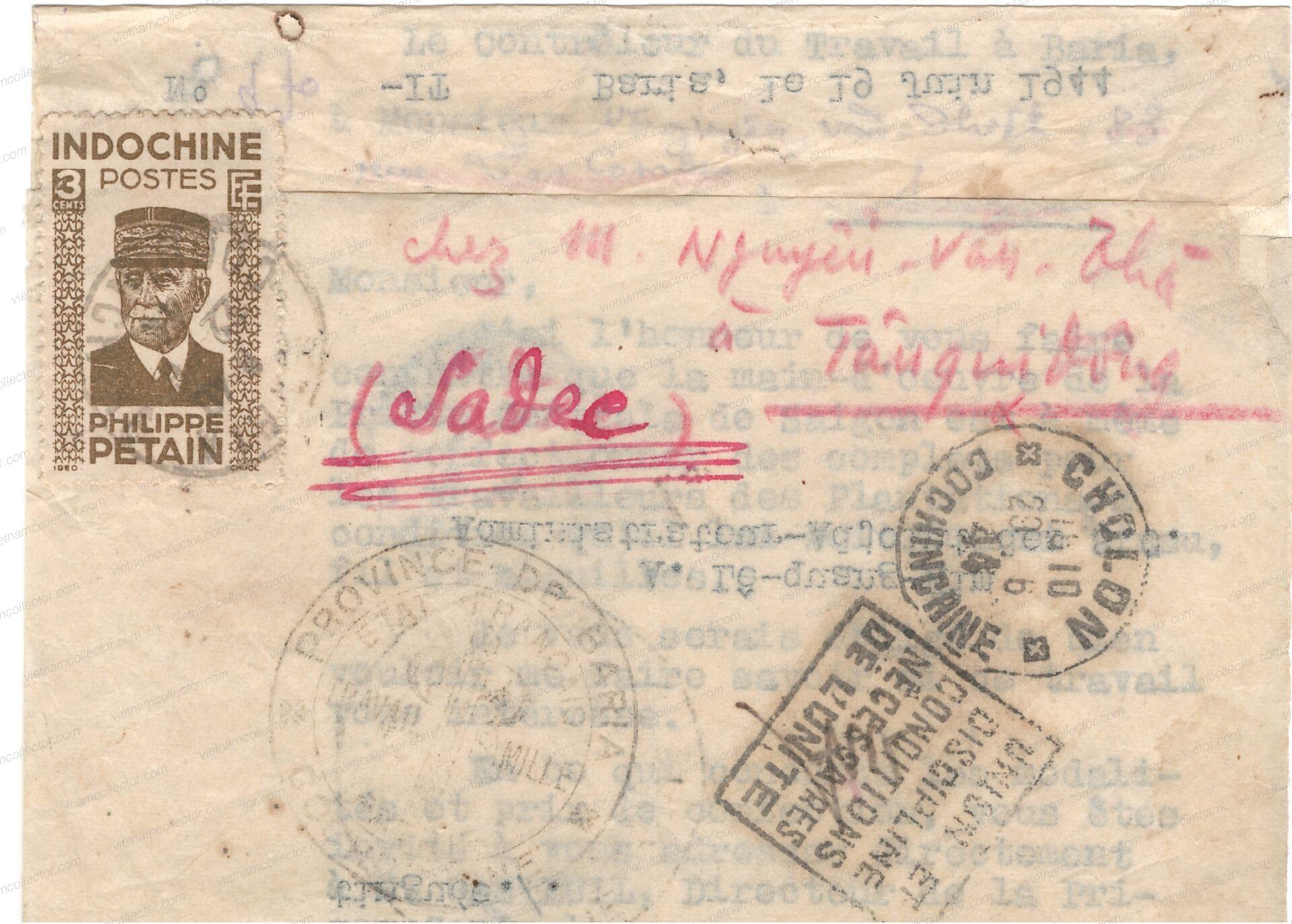
Multiple franking of the 3C Petain stamp in perforation 13.5 (so far unlisted in Michel) on a domestic letter sent from Saigon to Hanoi in April of 1943. This was under the Japanese occupation, in which domestic mail volume was very low. Hanoi arrival cancels on the reverse.
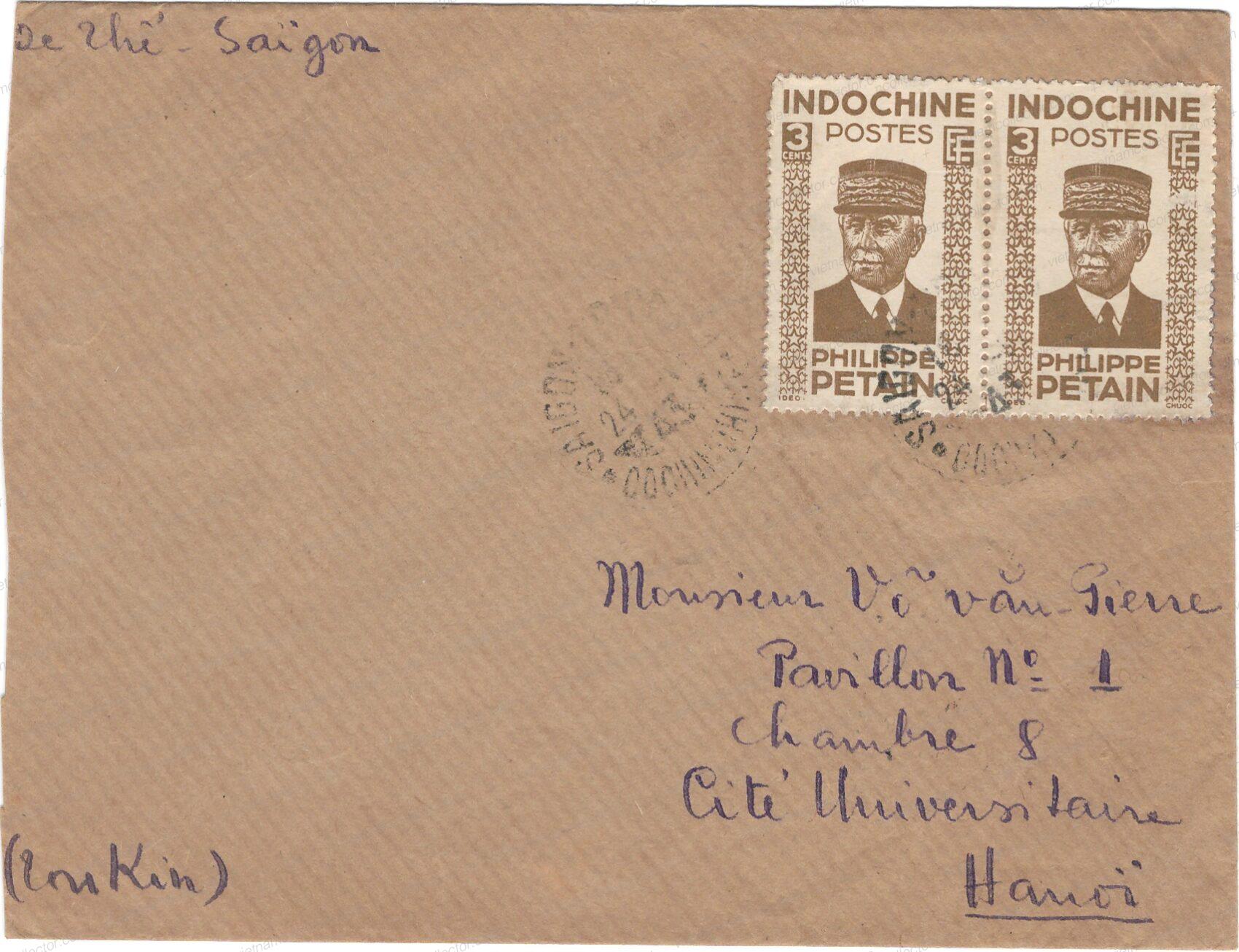
Mixed franking of the 3C Petain stamp (Perf 11.5 all four sides, not recorded in Michel) together with Anniversary of the National Revolution stamps (2) paying an overall postage of 15C on a domestic letter (tariff of October 3rd, 1944) sent from Kratie in Cambodia (rare cancel) to Saigon on January 11th, 1945. Saigon machine arrival cancel on the reverse.

Mixed franking of the 1C and 6C value paying an overall postage of 7C on a domestic letter sent during the Japanese Occupation from Dong-Choi (small post office) to the SICA Office in Le Thuy in April of 1943. Dong Hoi transit cancel on the reverse.
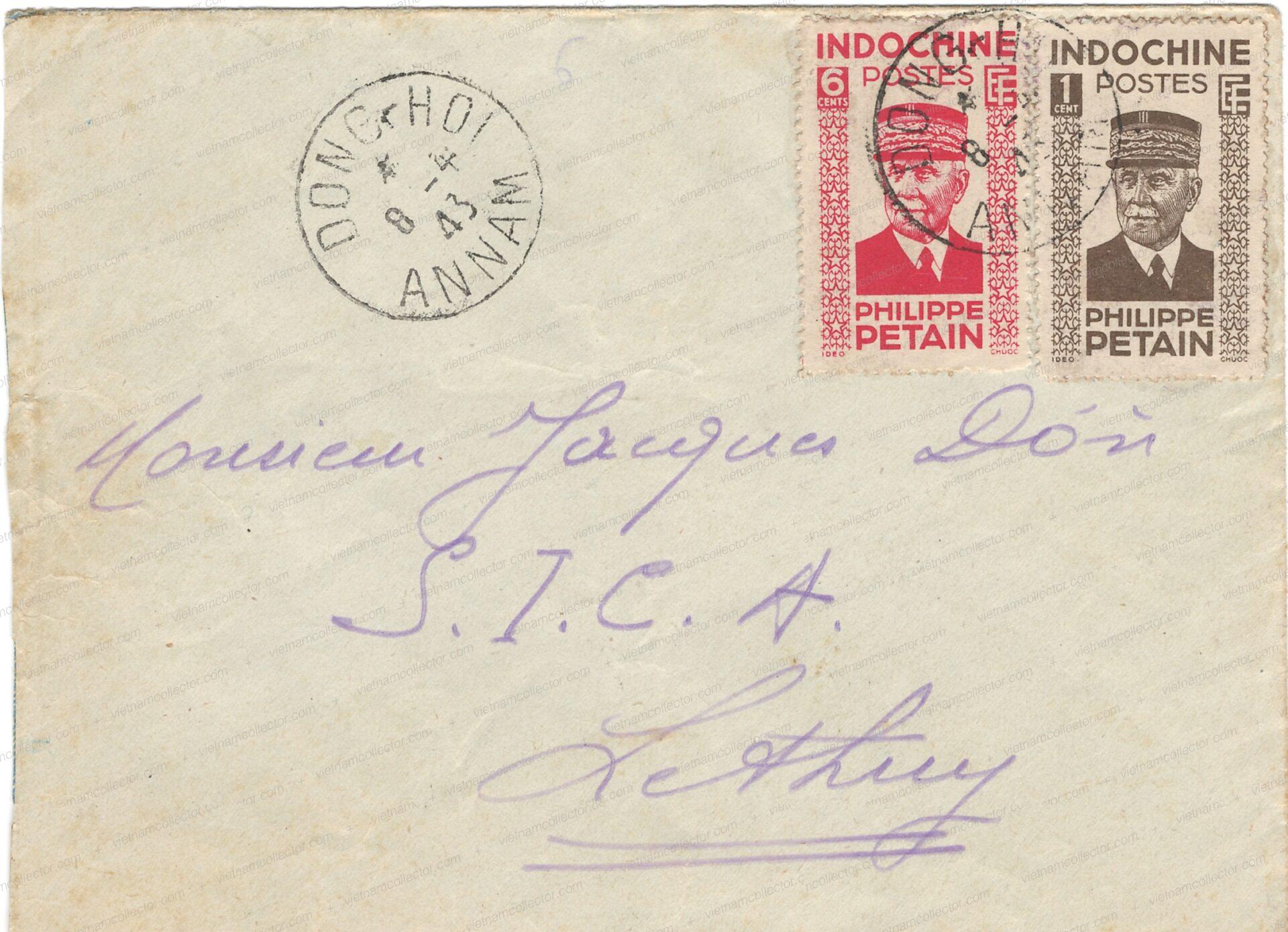
Rare single franking of the 6C value (Perf. 11.5:14) on a domestic letter sent from Dalat to Hue in January of 1943. Hue arrival cancel on the reverse.
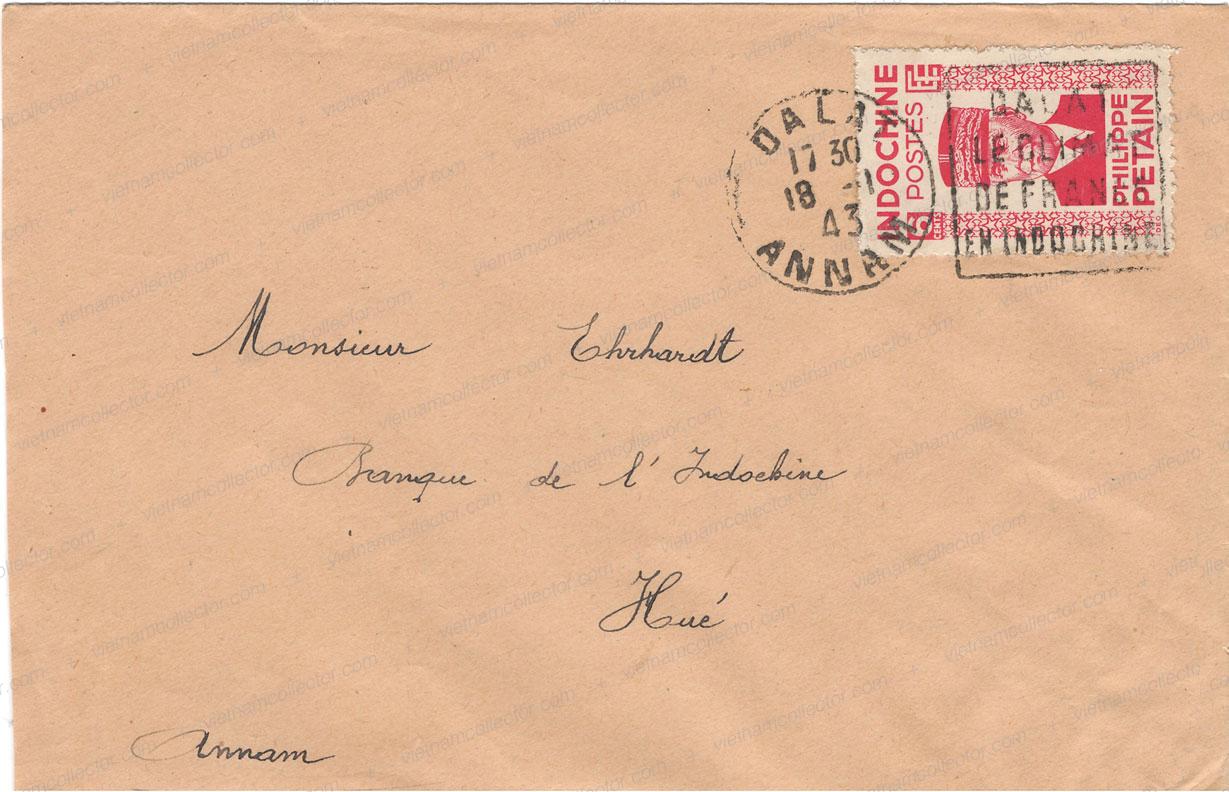
Mixed franking of the 3C and 6C value paying an overall postage of 9C on a rare domestic printed matter mailing sent in March of 1944 from Qui Hon to Ninh Hoa. Very few domestic printed matter items have survived the ravages of time. Note that the 3C value shows the variety “No white strips in Petain’s hat”
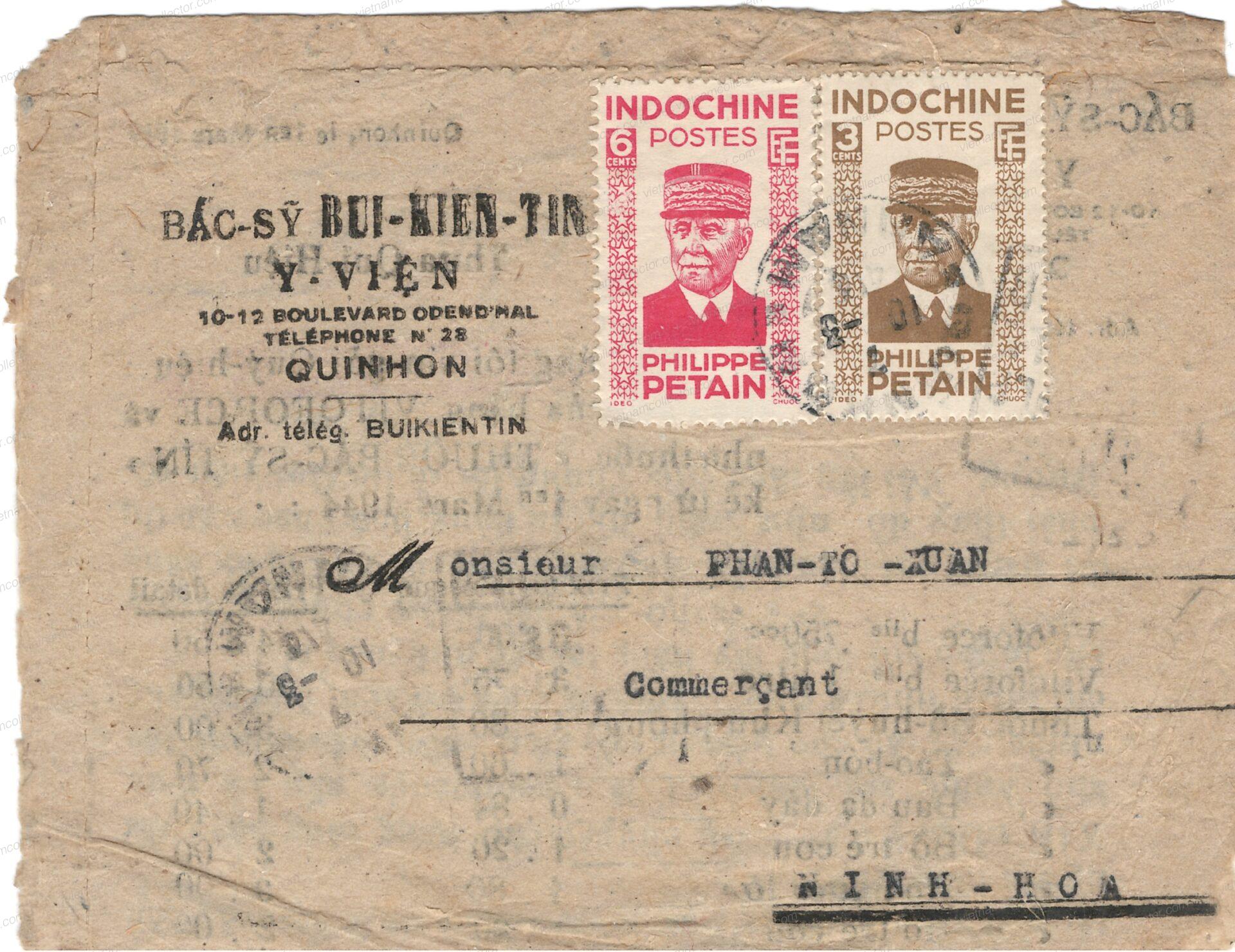
Detailed scan of the affected area.
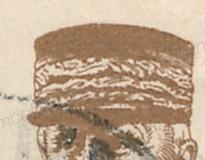
Mixed franking pof the 6C Petain stamp together with the 4C Doumer stamp paying the correct tariff of 10C on a domestic letter sent between May 15th to October 3rd of 1944 (when the domestic postage was increased to 15C) within Saigon. The letter was addressed to the wife of a French military officer Hartwig that was in charge of the postal censuring operation during the Japanese occupation. Hartwig was imprisoned in an interment camp after the Japanese Coup on March 9th, 1945.
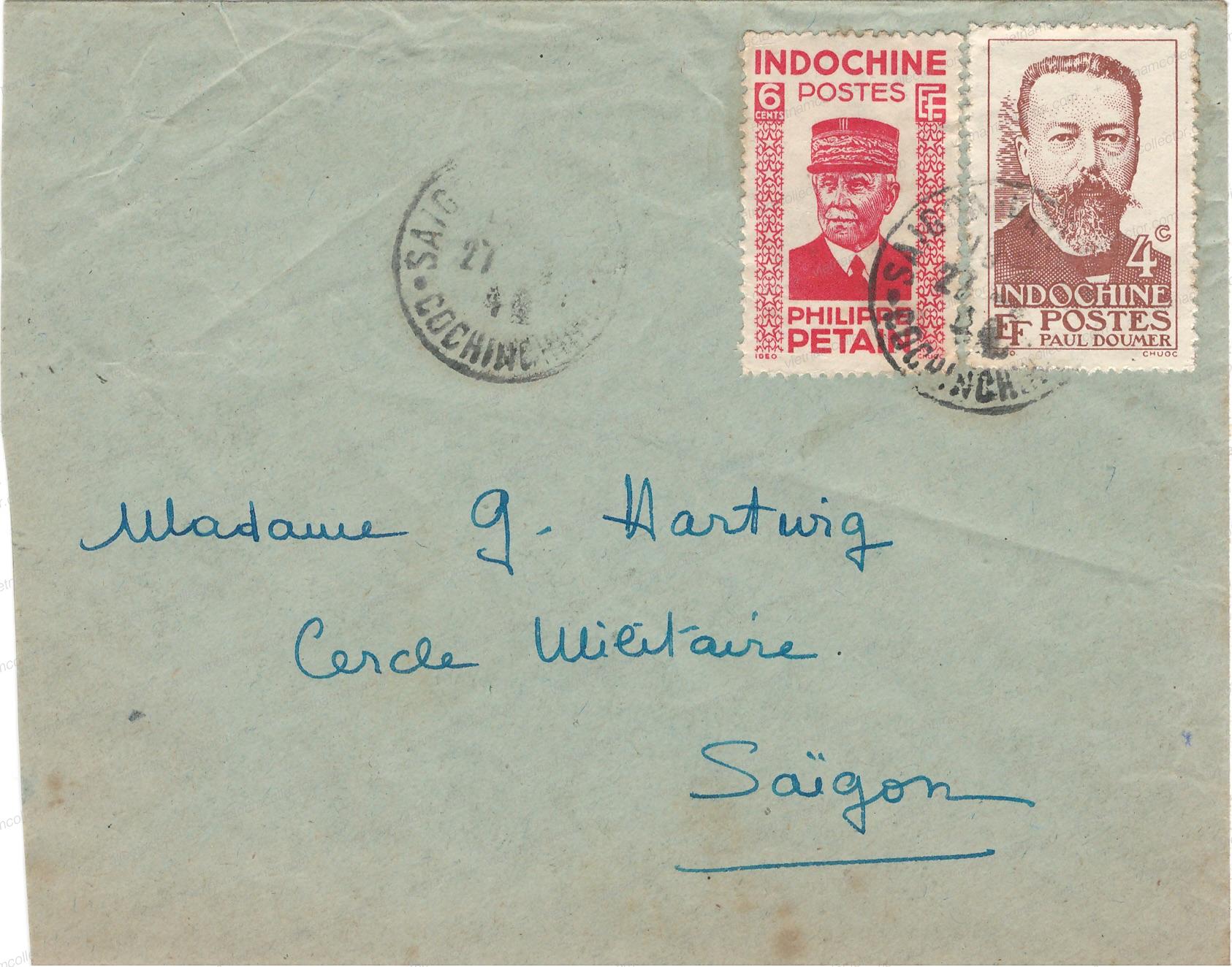
Mixed franking of the 3C and 6C values (2) within Saigon in what was most likely September, 1946 (the domestic letter tariff increased to 15C on October 3rd, 1944).
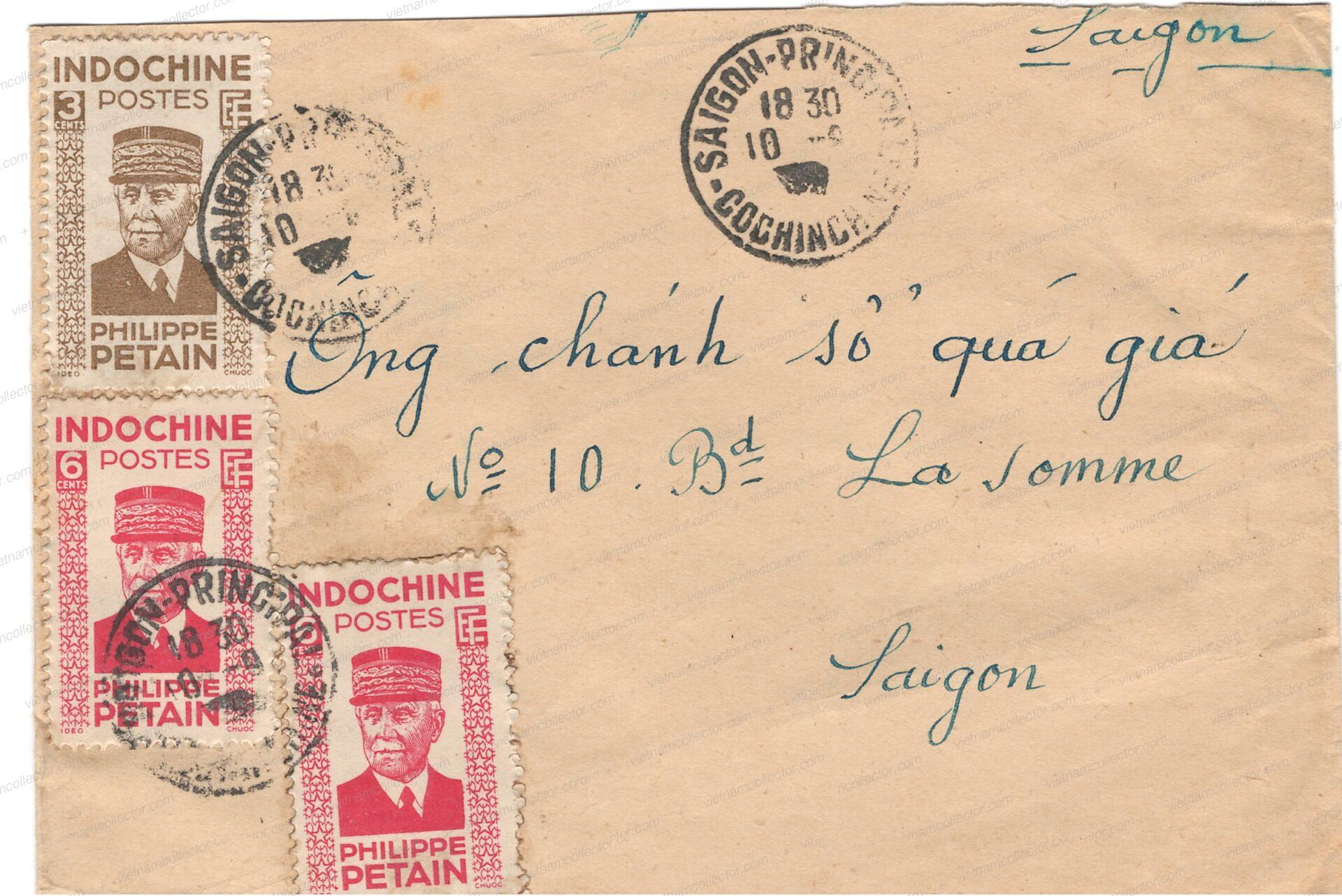
Mixed franking of the 6C Petain and 4C Pavie stamp paying an overall postage of 10C on a domestic letter sent during the Japanese Occupation from Transit Vinh to Mocay in July of 1944. Mocay arrival cancel on the reverse.
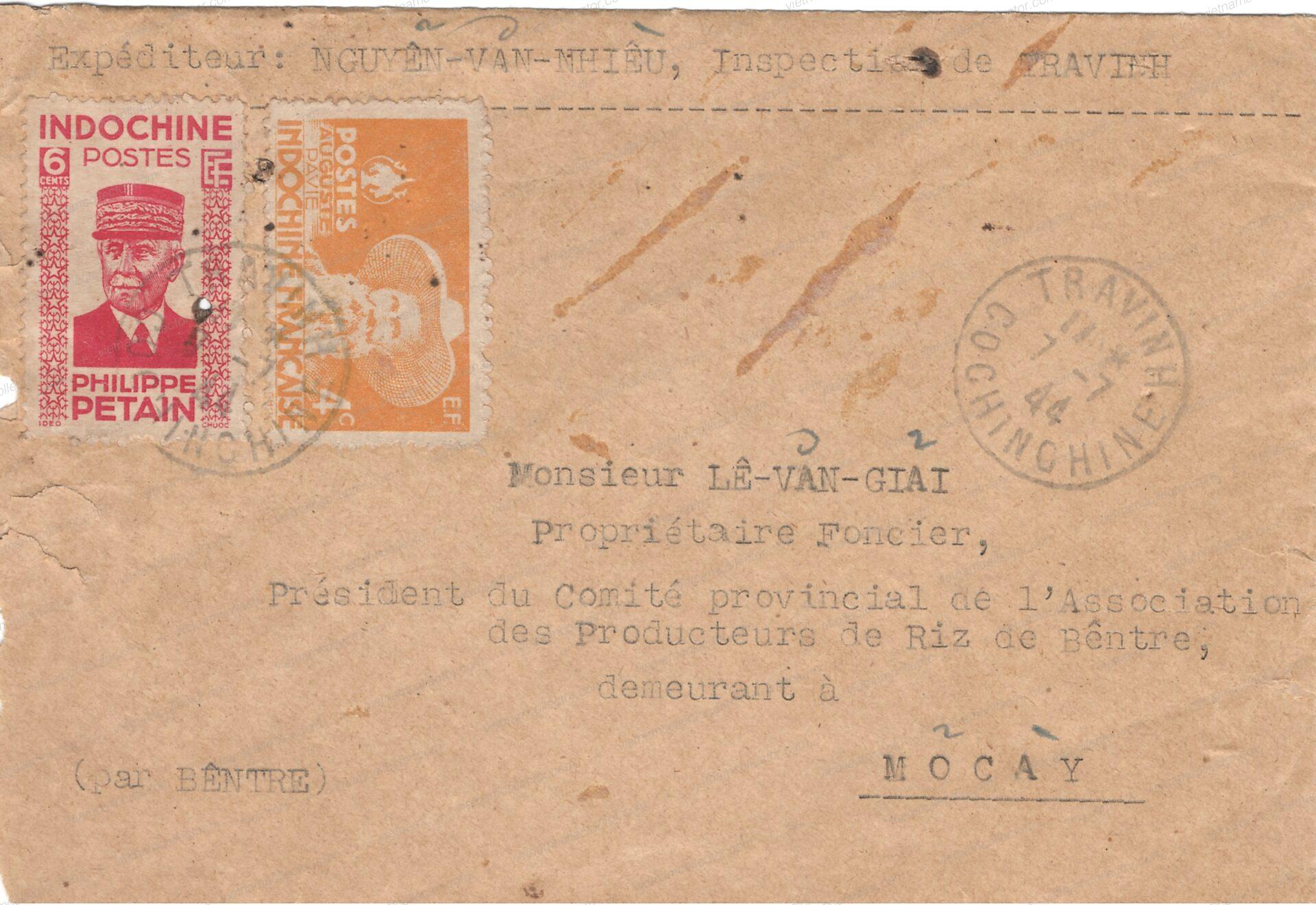
Mixed franking of the 6C Petain and 4C Pavie stamp paying an overall postage of 10C on a domestic letter (full contents preserved) sent during the Japanese Occupation from Baixau (small post office) to Cholon in August of 1944. Machine arrival cancel on the reverse.
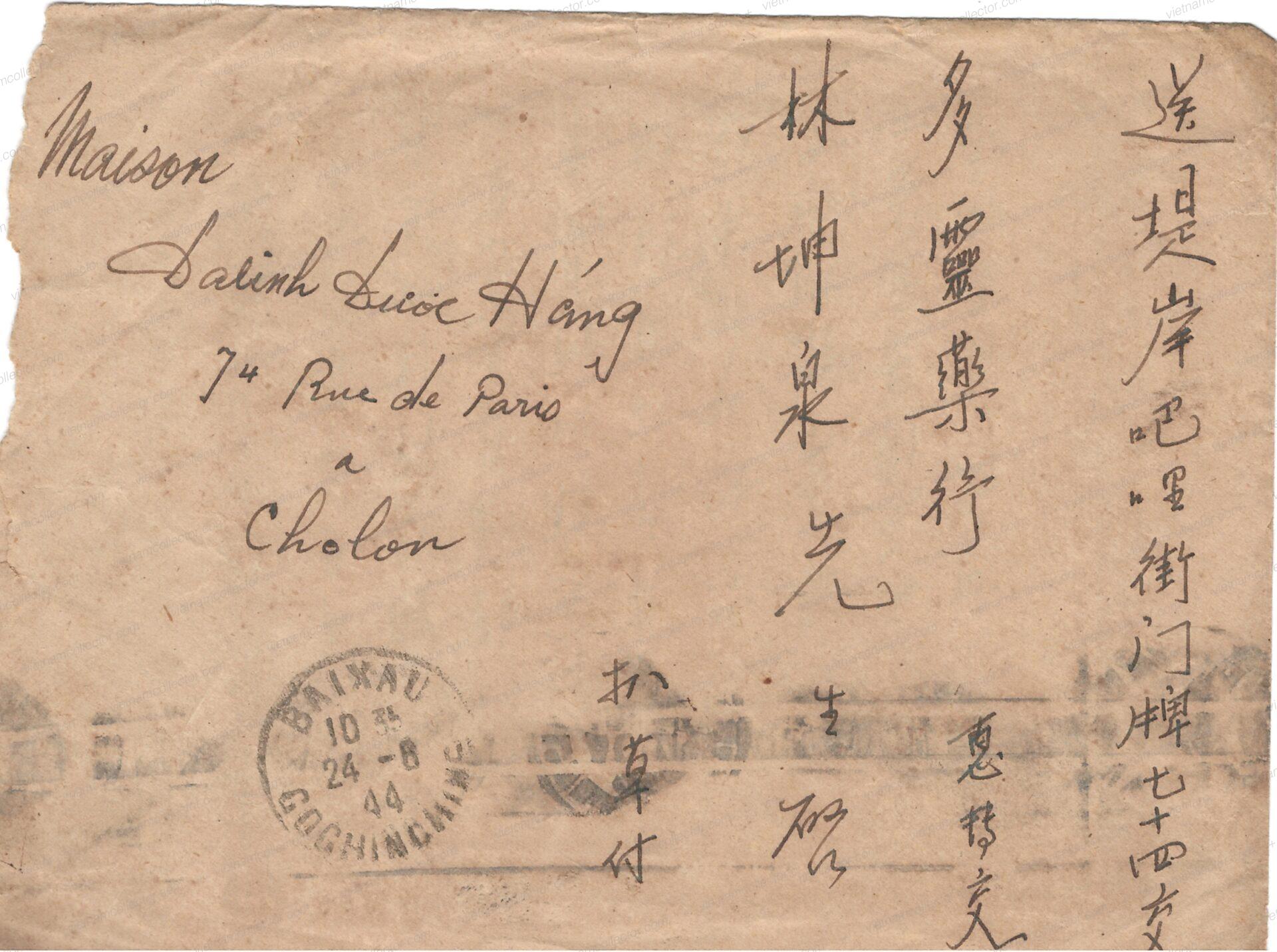
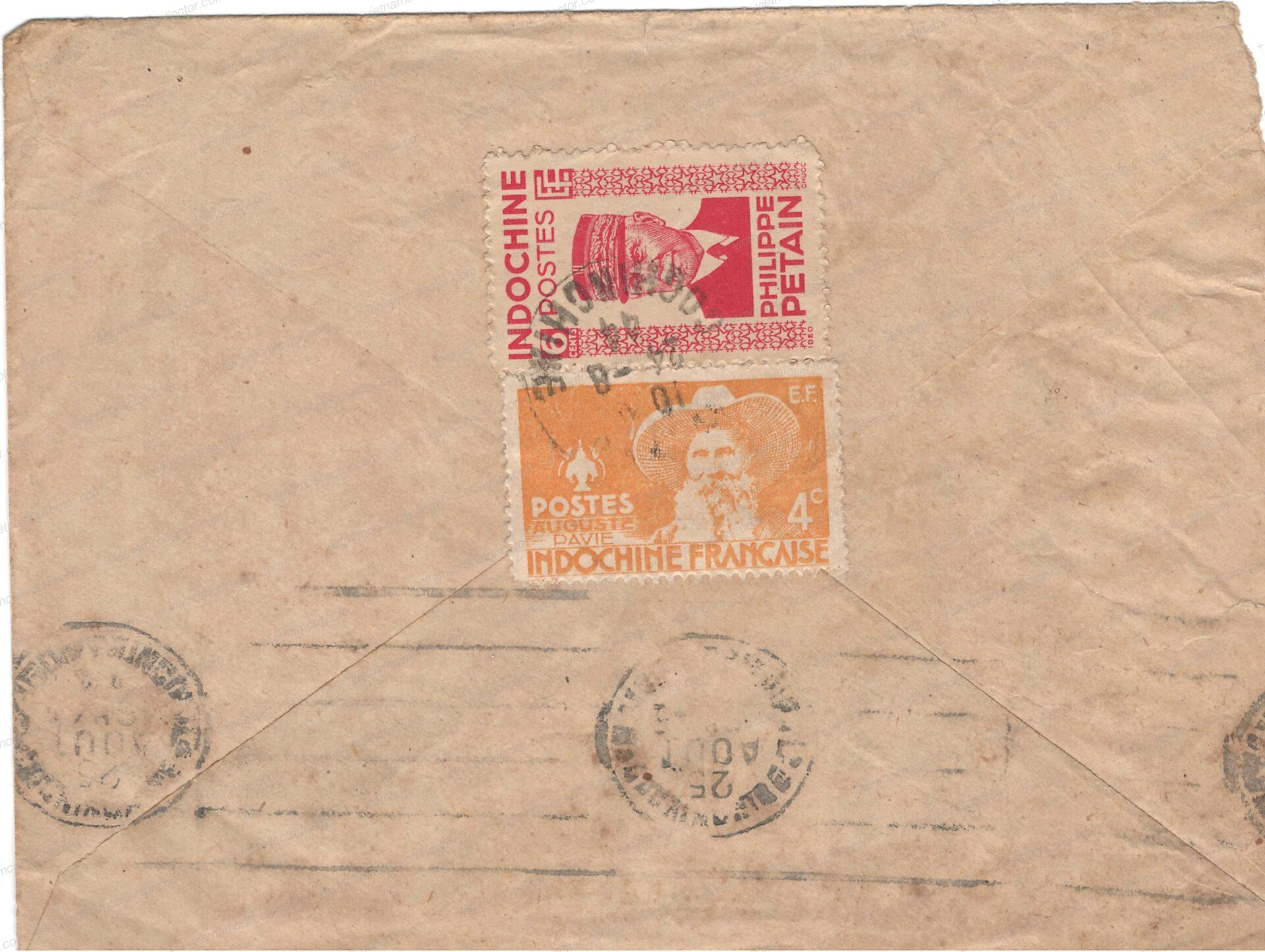
Single franking of the 6C value on a domestic letter on an adversity envelope sent to Phnom Penh during the Japanese Occupation in 1943. Faint transit/arrival cancel on the reverse.
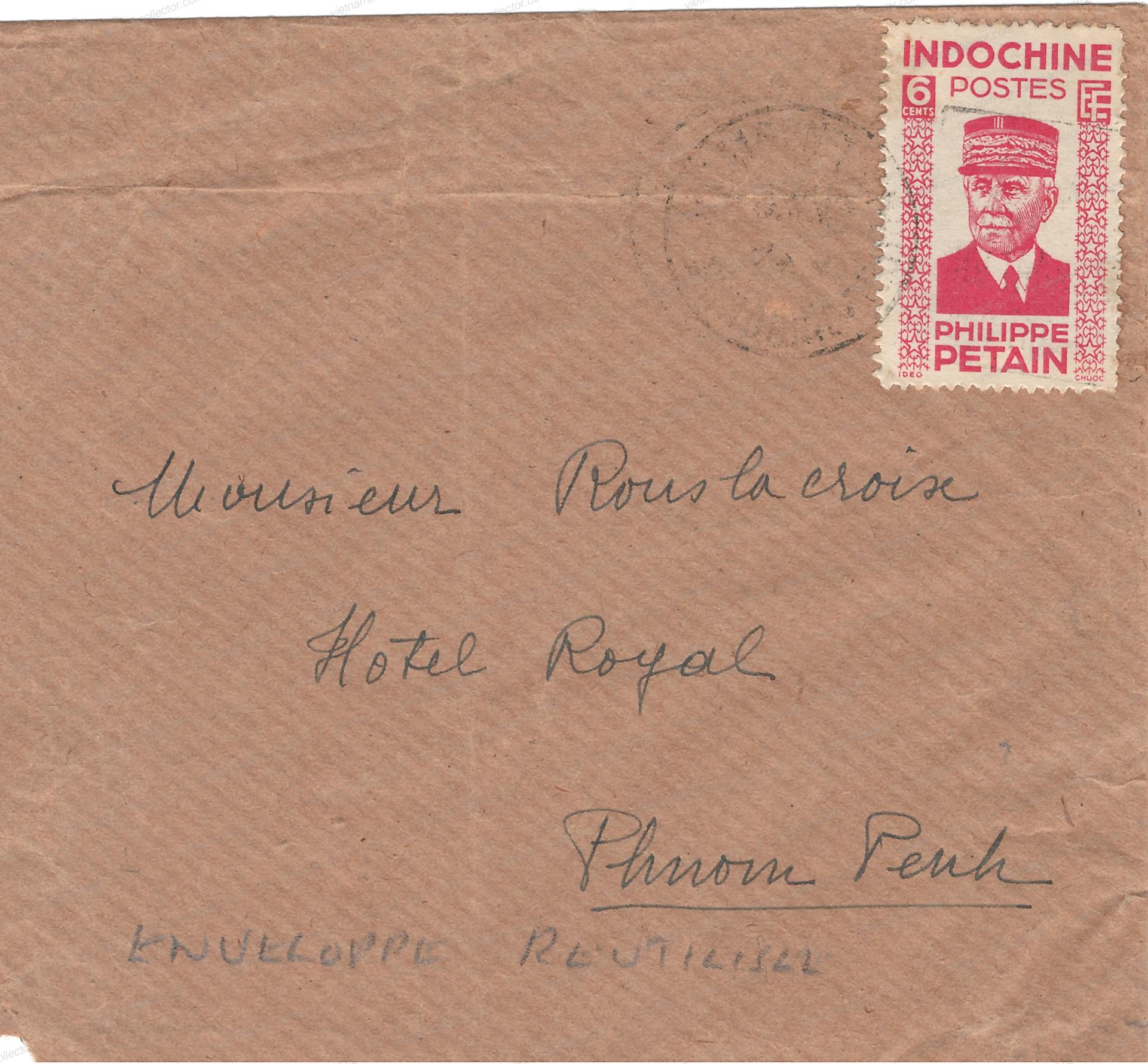
Mixed franking of the 6C Petain value (6) together with the 2C Domestic Scenes II (2) paying an overall postage of 34C on a domestic letter sent from Long Xuyen to Saigon in January of 1943. This was during the Japanese Occupation but the letter was apparently not censored. Note that two of the 6C stamps on front show the variety “Petain’s hat only shows two instead of three white lines”.
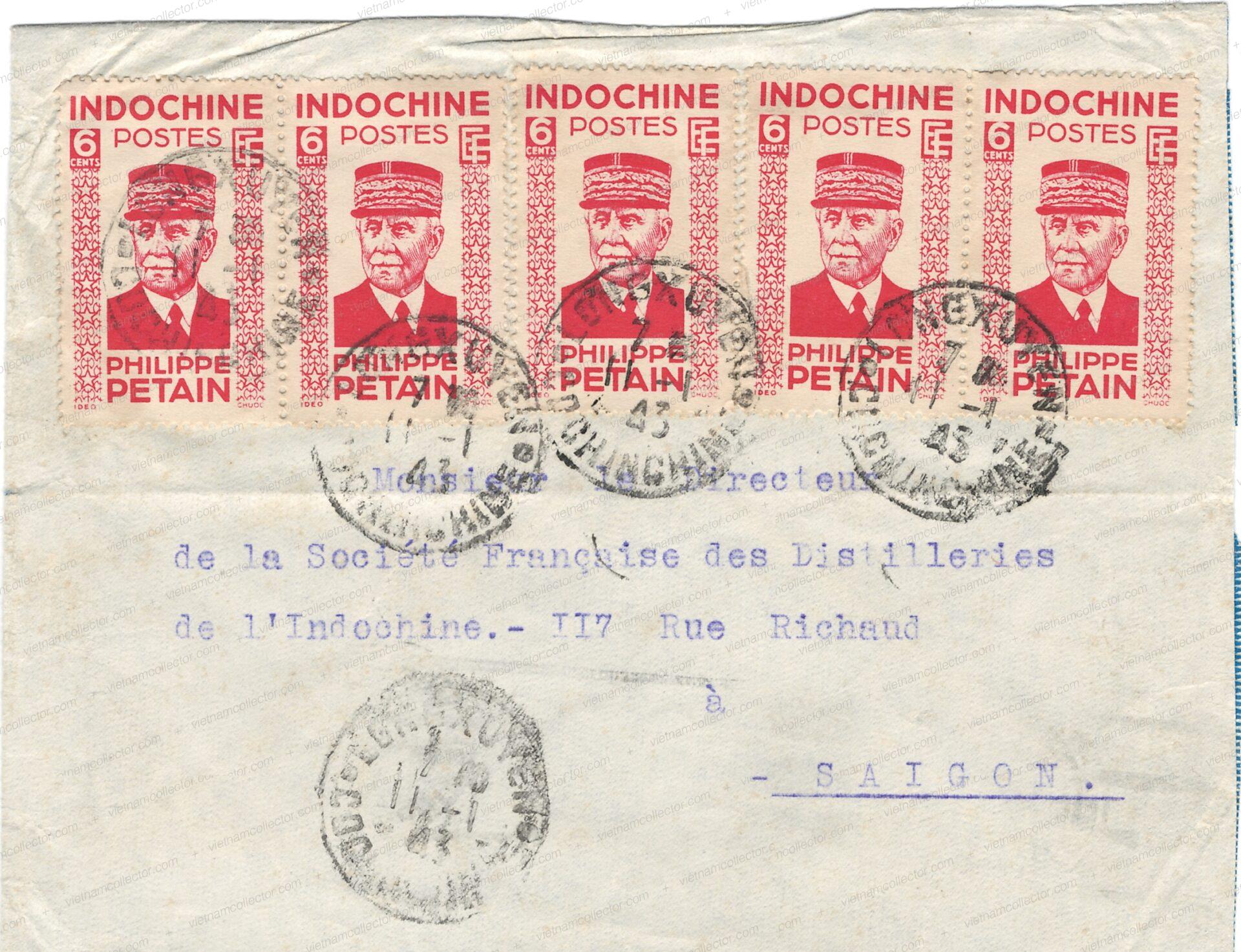
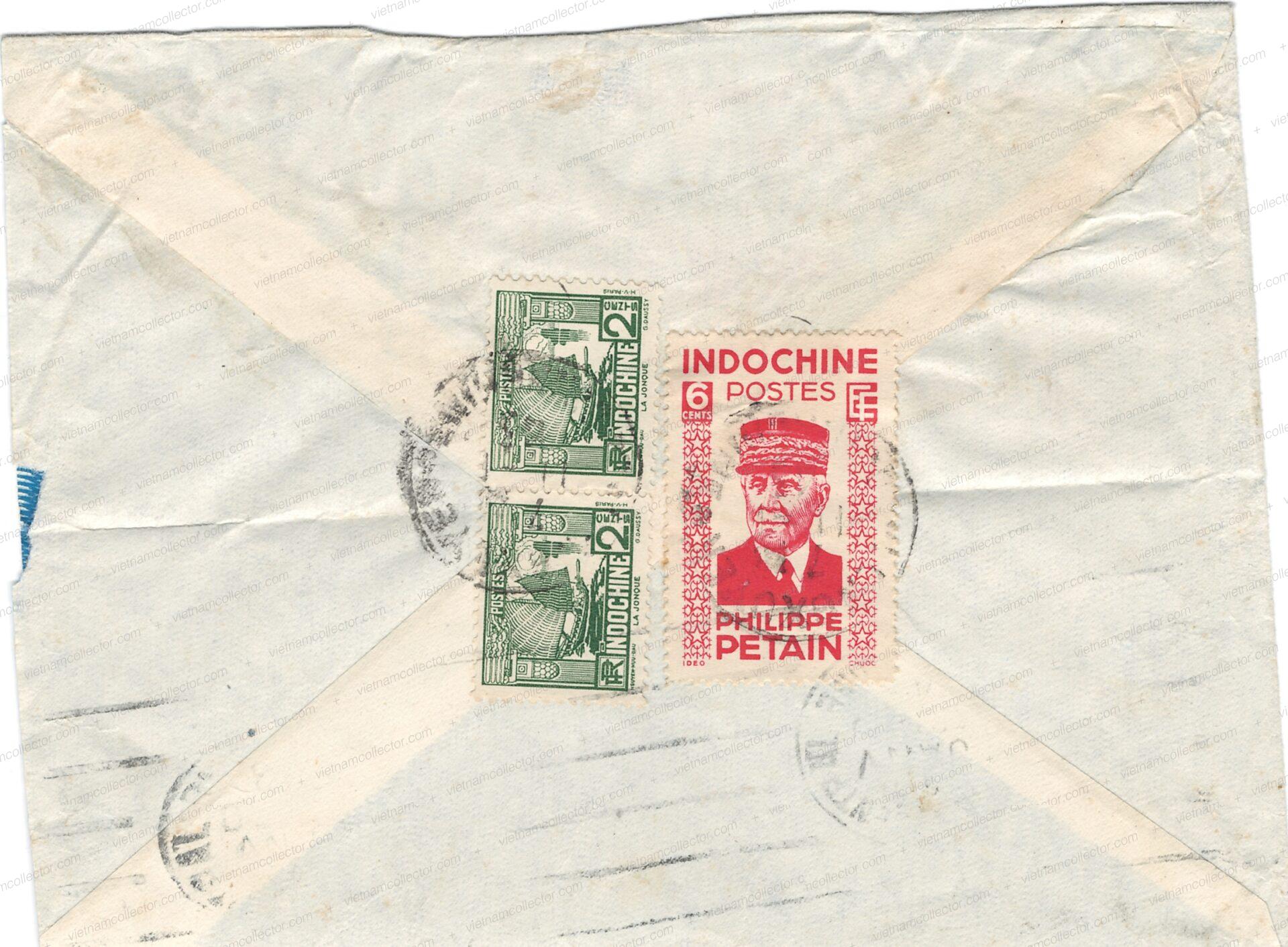
Mixed franking of the 6C Petain and 30C Airmail stamps paying an overall postage of 36C on a domestic registered letter sent in June of 1943 from Hai Phong to Hai Duong. Hanoi “Bis” censor, Hanoi transfer cancel and Ha Duong arrival cancels on the reverse.

Here is a letter that actually represents a stealth Viet Minh letter. It pays there correct 15C tariff that came in force on October 3rd, 1944. It was sent on August 22nd, 1945 from Ben Cat to Hon Quan. The Japanese had just surrendered on August 15th, 1945 to the United States so the postal administration had already been taken over by the Viet Minh who had used the power vacuum to take over administrative control of the country. Thu Day Mot transfer cancel from August 23td, 1945 on the reverse.

A postal stationary of the 6C was also produced equivalent to the domestic letter rate up to 10g in weight (Tariff from April 16th, 1942). Here is theming version of this rare stationary.
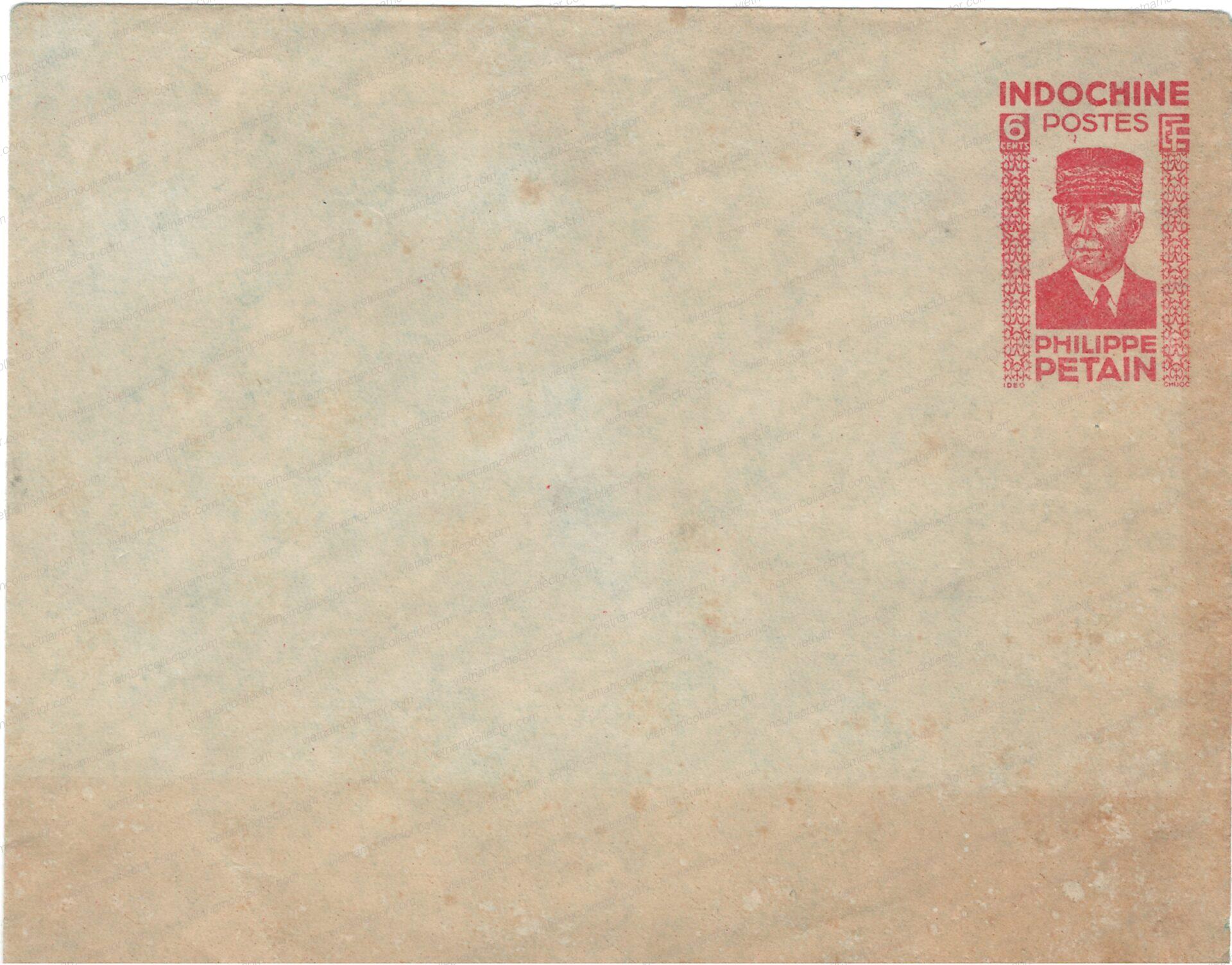
Postal stationary of the 6C value sent from Bao Lac (small post office) to Hanoi in May of 1943. This was during the Japanese Occupation but the letter was apparently not censored. Cao Bang transit and Hanoi arrival cancel on the reverse.
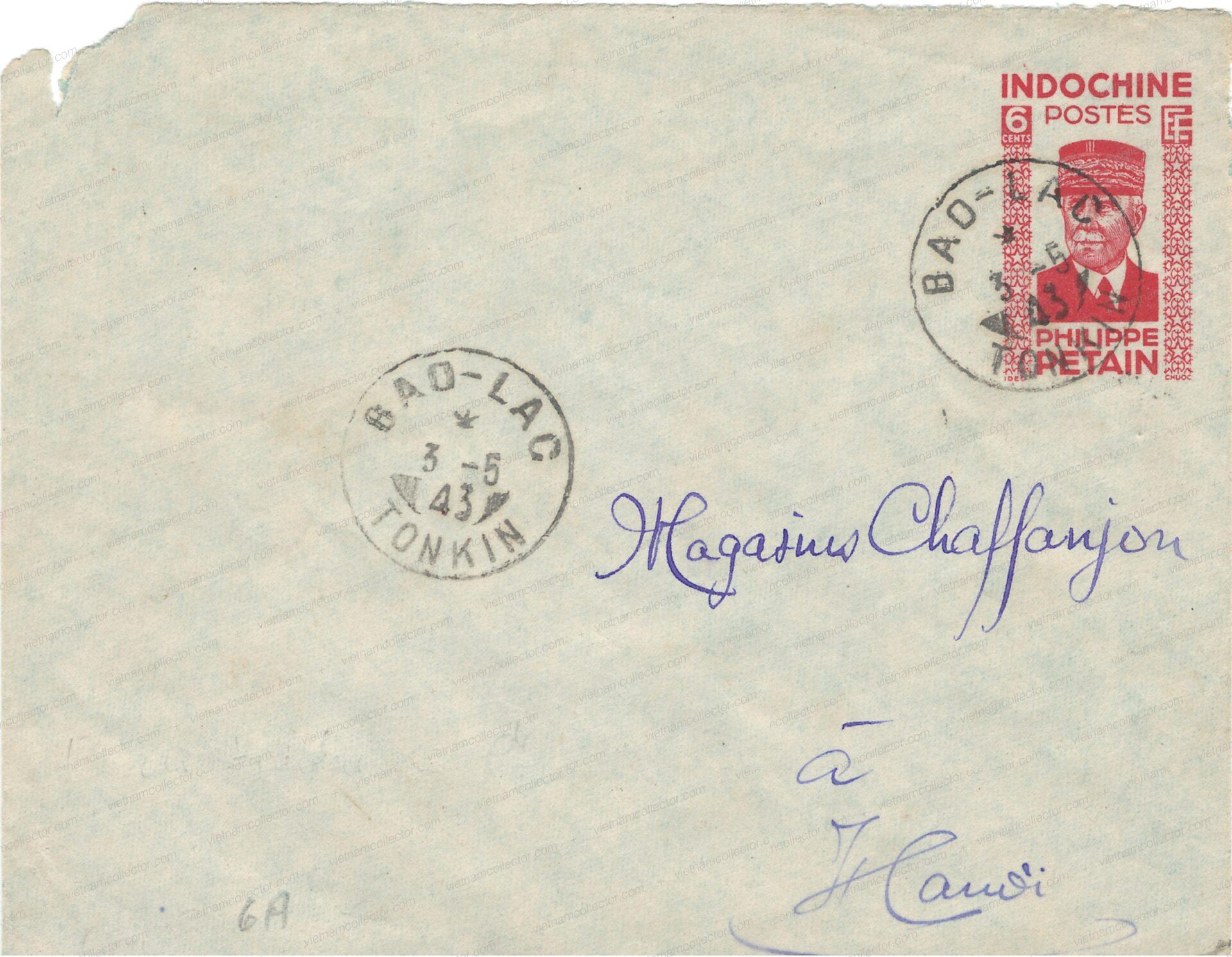
Postal stationary of the 6C value sent from Annan to Le Thuy in 1943. This was during the Japanese Occupation but the letter was apparently not censored.
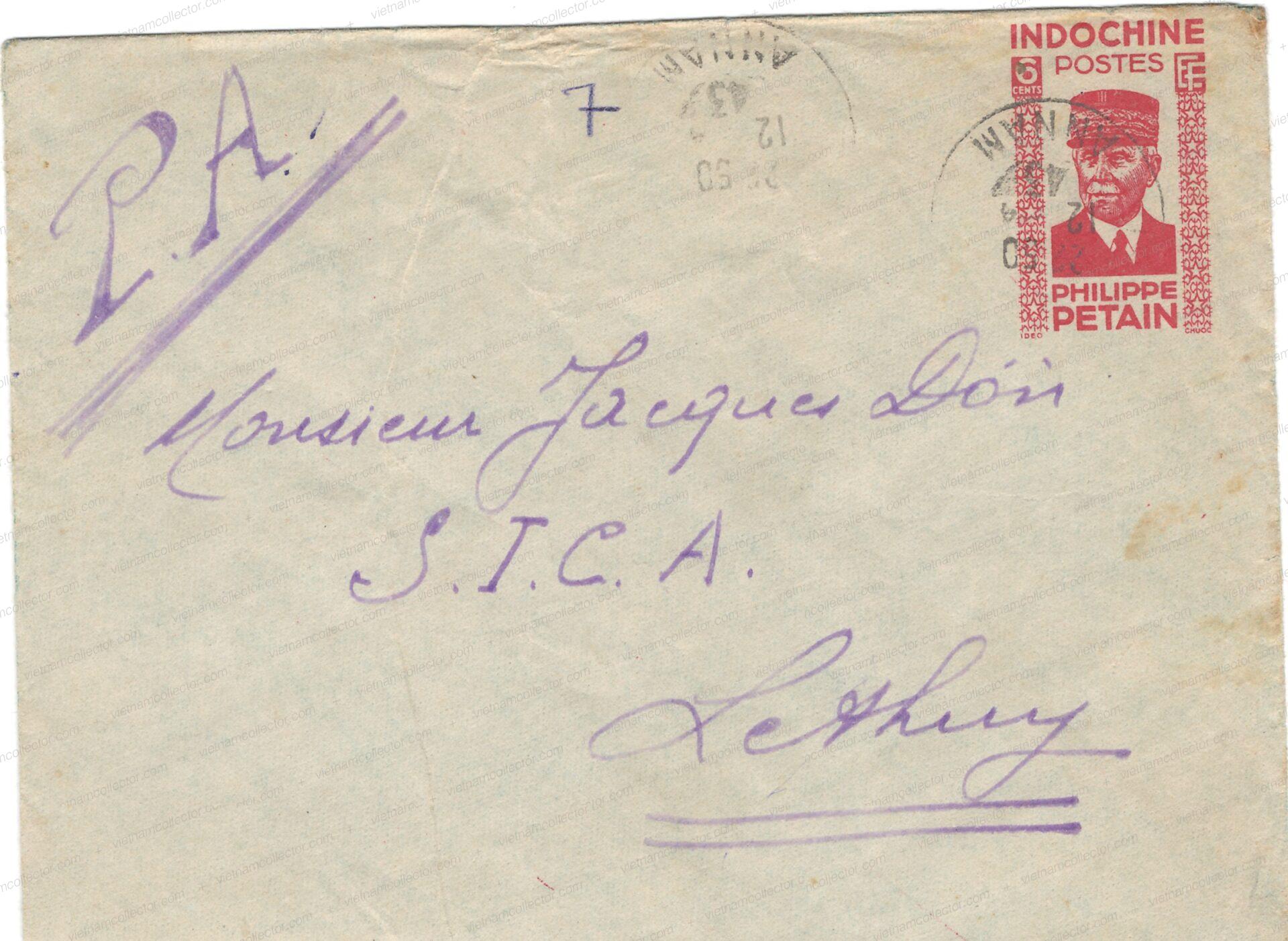
Postal stationary of the 6C value sent from Thai Dinh (small post office) to “Ingenieur Chef du Services de Mines” in Hanoi in August of 1943. This post was held by the well known philatelist Jacques Dessrousseaux. The letter was sent during the Japanese Occupation but the letter was apparently not censored. Hanoi arrival cancel on the reverse. Ex Dessrousseaux.
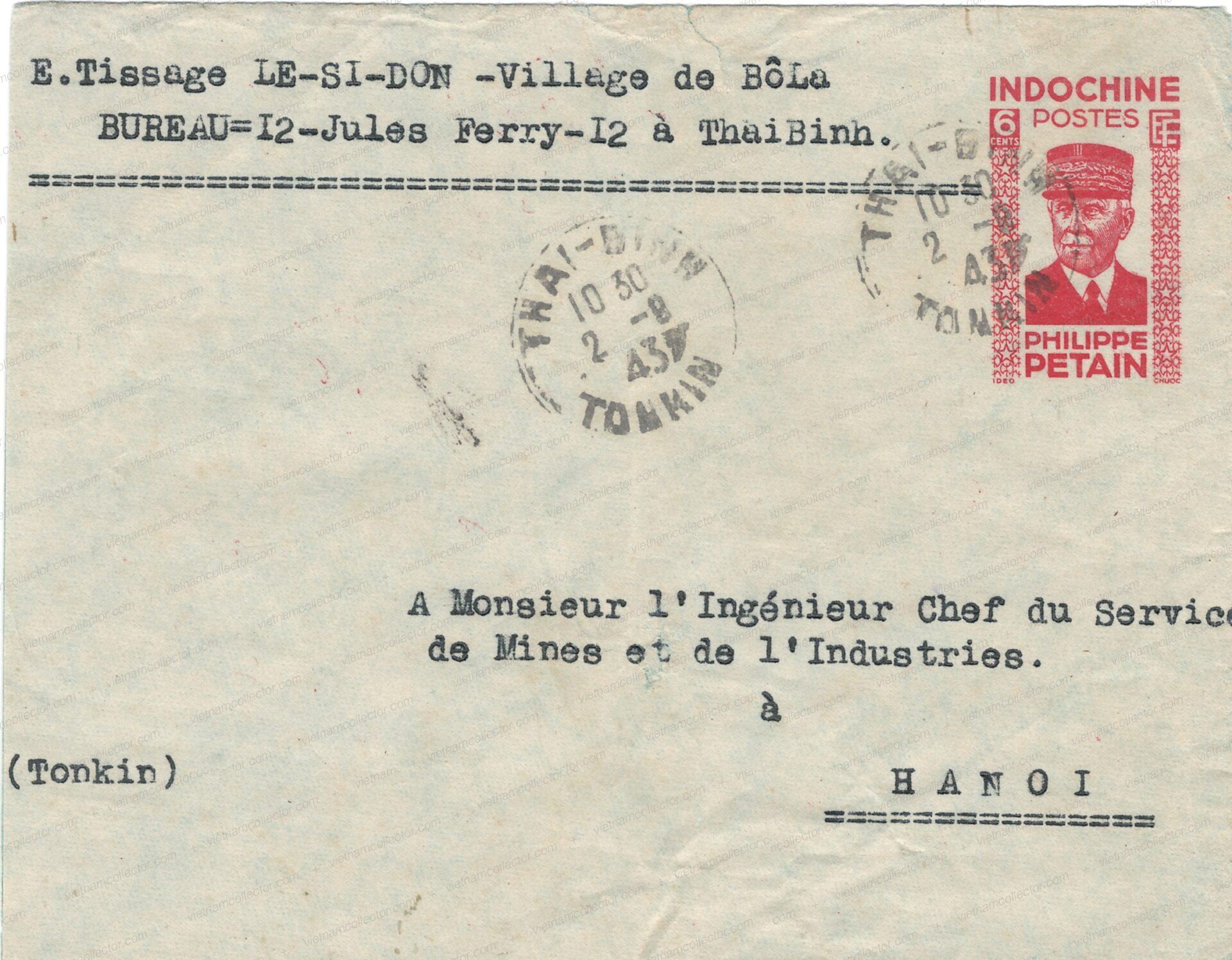
6C Petain postally stationary together with stamps from the National Donation set (2) and the overprinted Domestic Scene stamp paying an overall postage of 46C on an international letter sent on July 9th, 1943 from Thu-Xa (small post office) to Singapore. This is slightly in excess of the required tariff of 40C. (Tariff of April 1st, 1942). Singapore was already occupied by the Japanese so the letter was not censored. Quan Ngai and Saigon transit cancels.
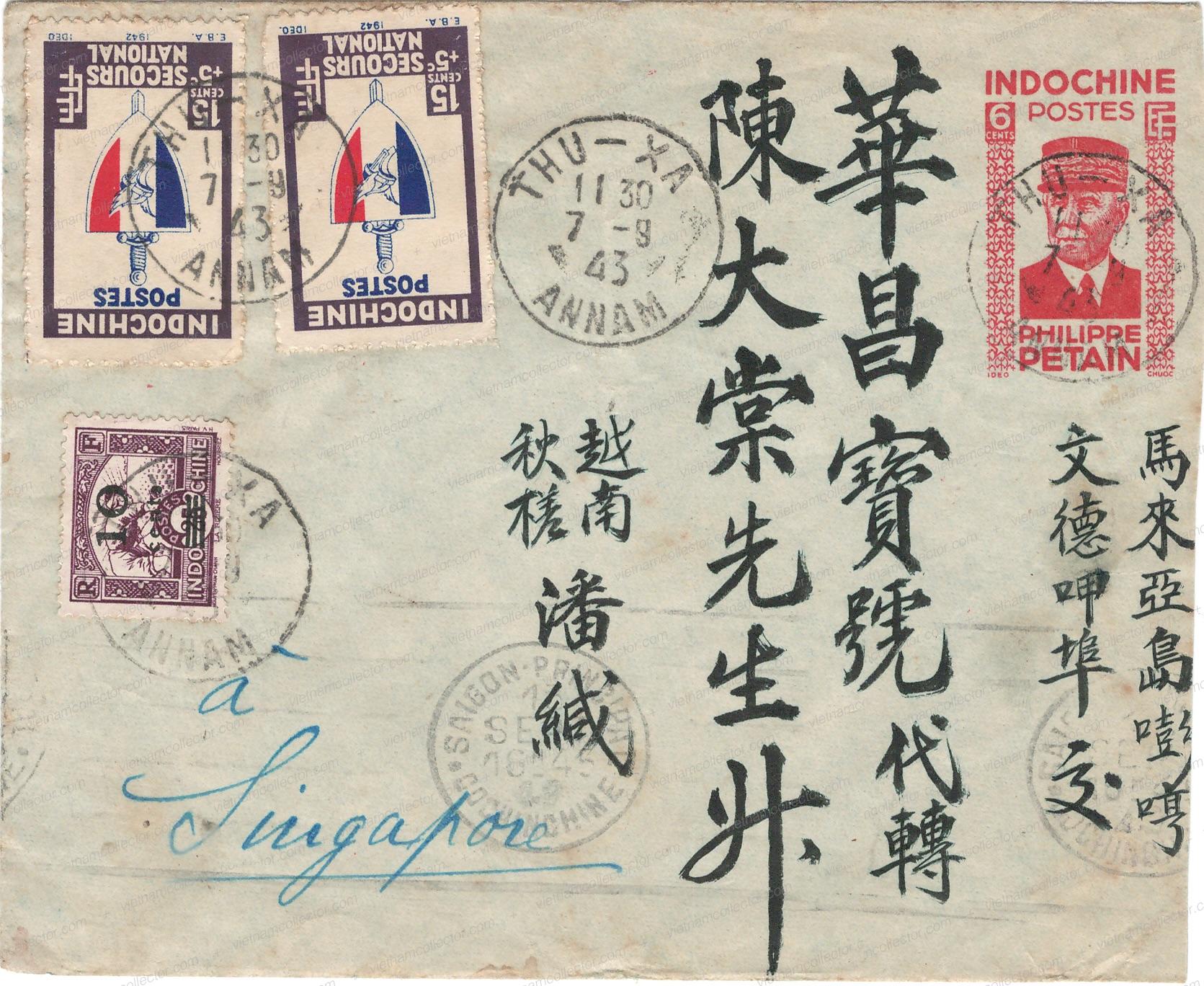
6c Petain postal stationary plus 4C paying an overall postage of 10C on a domestic letter (tariff as of December 1st, 1943) sent in December of 1943 from Le Bokop, Cambodia (rare cancel) to Guy Hartwig, a French military officer that was in charge of postal censorship in Saigon at the time. After the Japanese coup in Indochina on March 9th, 1945 Hartwig was imprisoned in an interment camp by the Japanese. Pnom Penh transit cancel on the reverse.
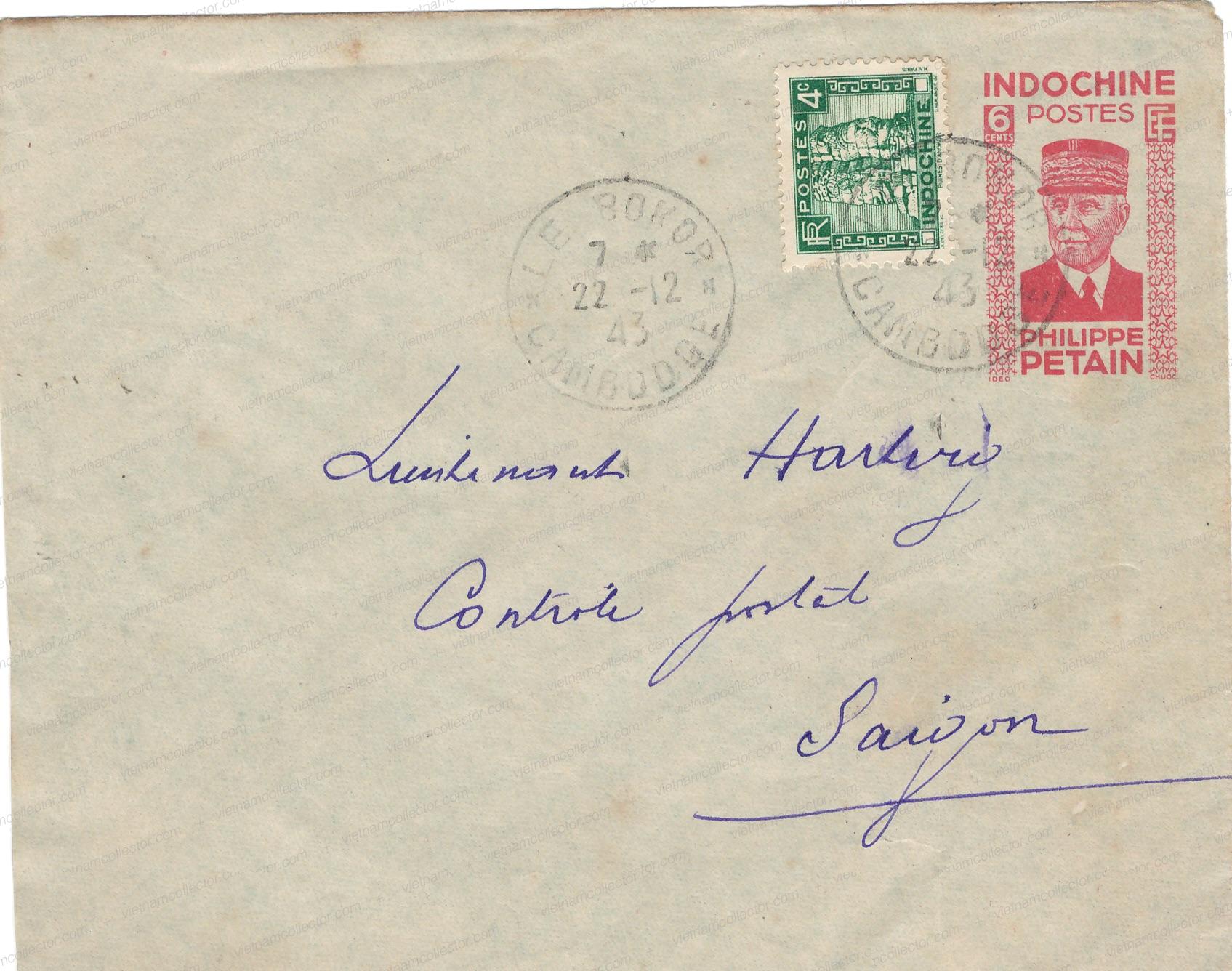
Two mixed frankings of the 6C Petain stationary plus the 3C Petain and 6C Vong stamp paying the correct domestic letter rate of 15C (Tariff as of October 3rd, 1944) on two letters sent from Baclieu to Ben Tre and Lang Song on September 22nd, 1945. By that time the Viet Minh had already taken over the administrative control from the Japanese so these letters can be considered stealth Viet Minh letters.
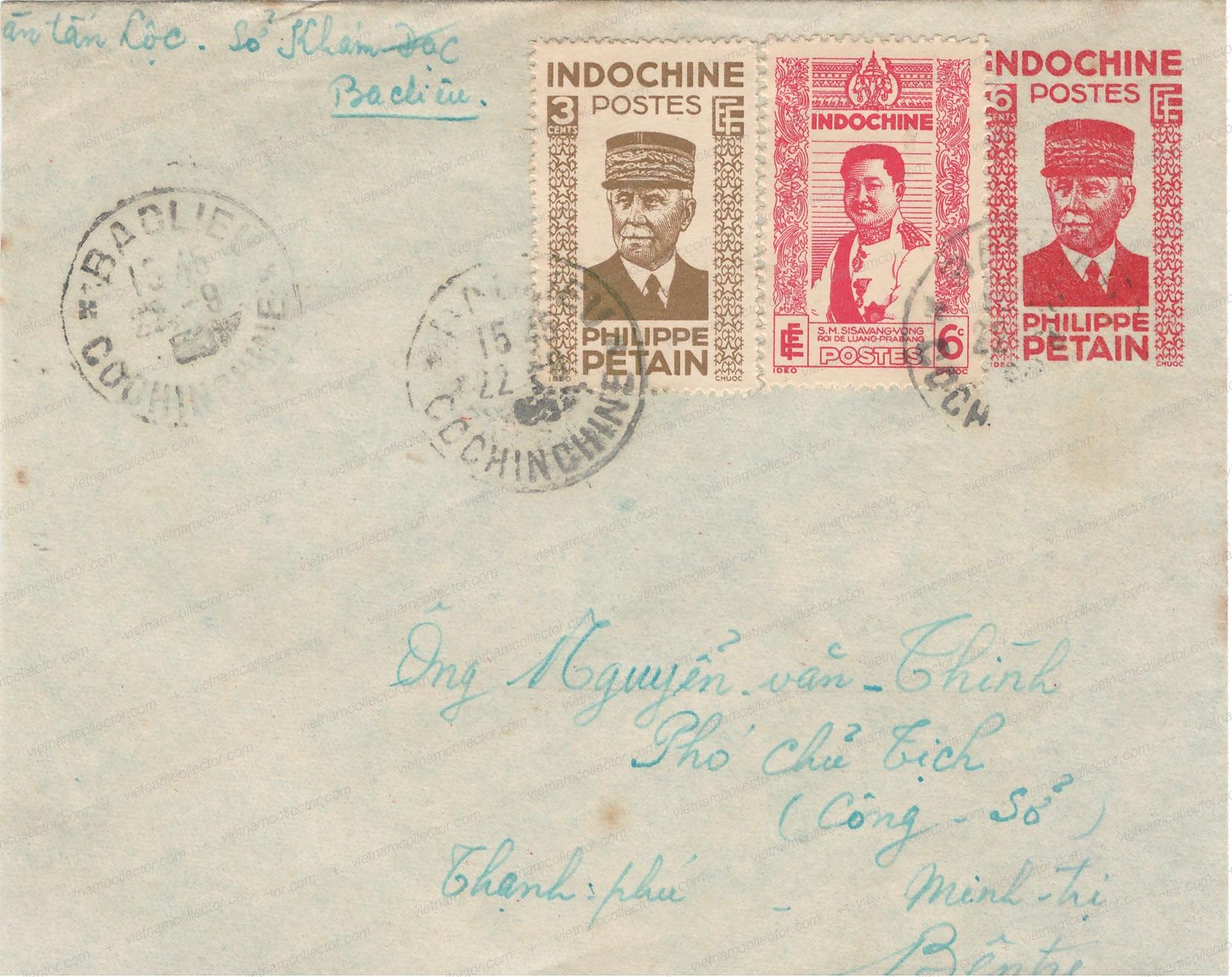

Single franking of the 10C Petain stamp paying the correct inland postage on a domestic letter sent in December of 1943 from Saigon to Cap Saint Jacques. Cape Saint Jacques arrival cancel on the reverse. The letter was addressed to Guy Hartwig who was a French military officer in charge of postal censorship operations during the Japanese occupation. After the Japanese Coup of March 9th, 1945 Hartwig was imprisoned in a detention camp.
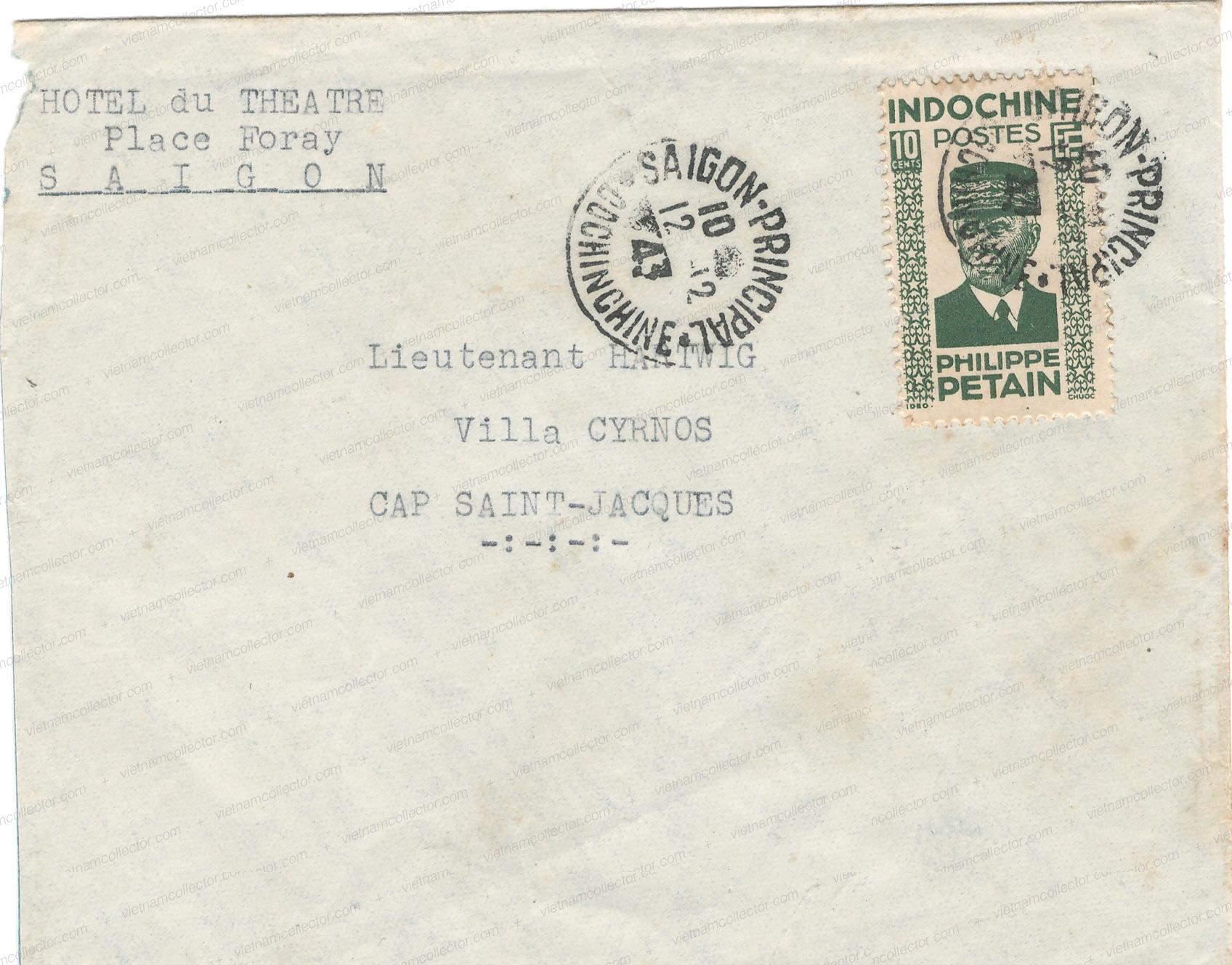
Single franking of the 10C Petain stamp paying the correct inland postage on a domestic letter sent by the Asia Life Insurance Company in December of 1943 from Hanoi to Saigon. The letter was addressed to Guy Hartwig who was a French military officer in charge of postal censorship operations during most of the Japanese occupation. After the Japanese Coup of March 9th, 1945 Hartwig was imprisoned in a detention camp.
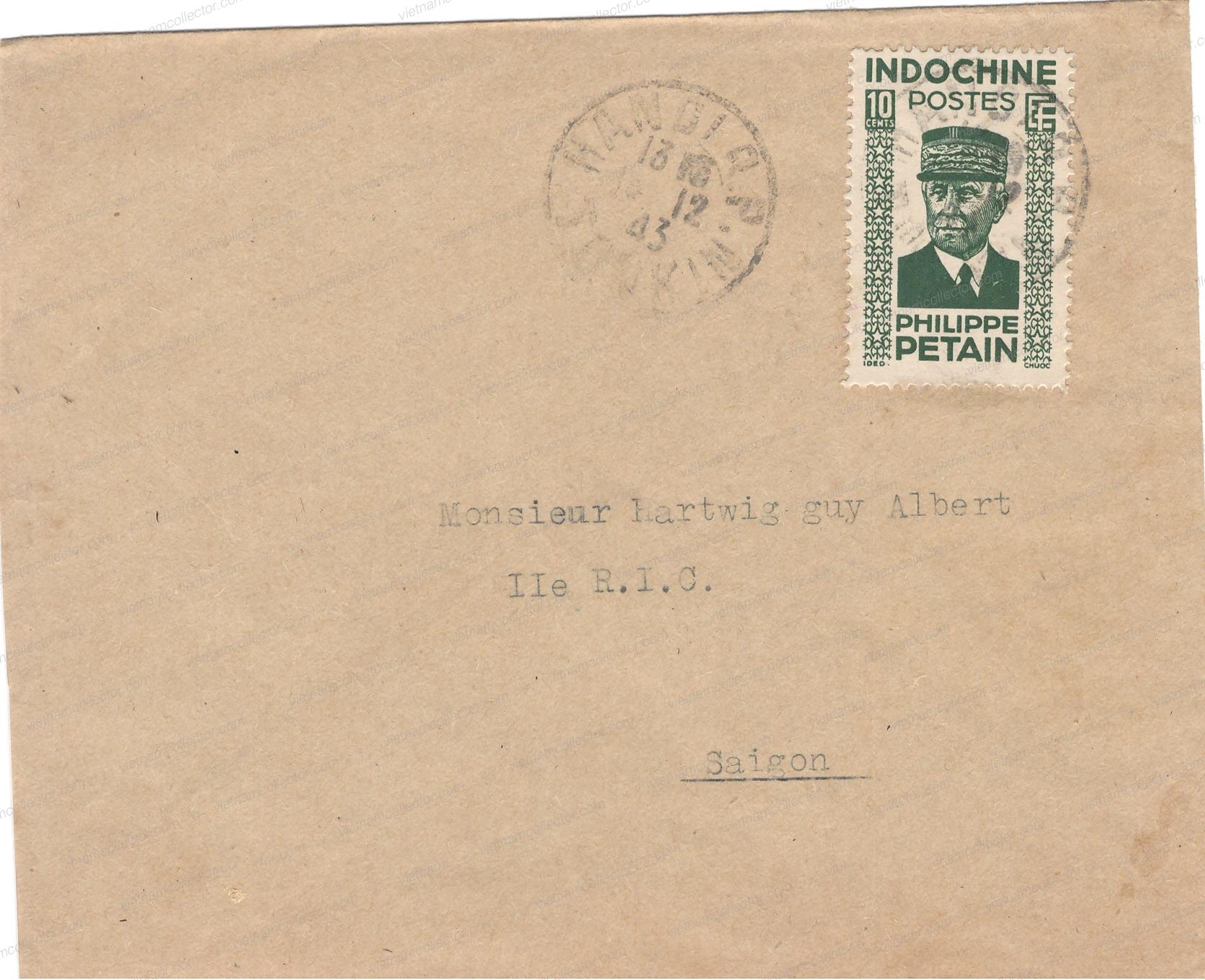
Mixed franking of the 1C Seafarer stamp together with stamps from the Petain and Domestic Scences II sets paying an overall postage of 15C on a domestic air mail letter sent from Soc Trang to Saigon in January of 1944.
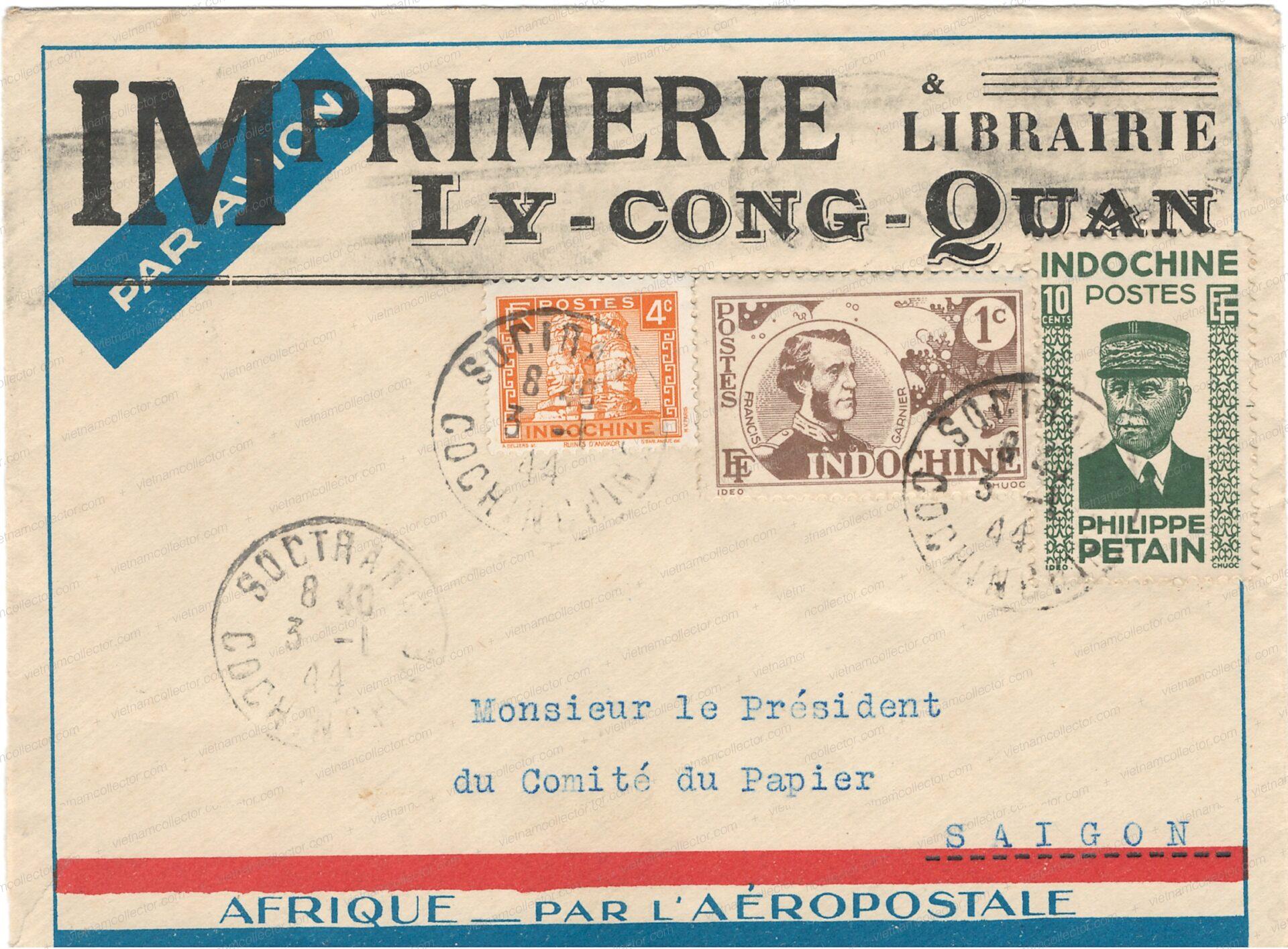
Single franking of the 40C Petain stamp paying the standard international letter rate on a letter that was sent on September 9th, 1945 from Saigon to a destination abroad. That was just 6 days after the formal Japanese surrender in World War II. Since the contents is missing one cannot say to where the letter was addressed to but a good guess would be Japan or another country still occupied by Japan. Although the letter was mailed by Banque de L’Indochine, normally a trusted source that was immune to postal censorship by decree, the letter was nevertheless censured in Saigon (C2). The censorship exemption to the bank that existed throughout a large portion of the Japanese occupation may have been revoked after the Japanese Coup on March 9th, 1945. International letters during the Japanese occupation period are very rare and were primarily sent to Japan or places still occupied by Japan.
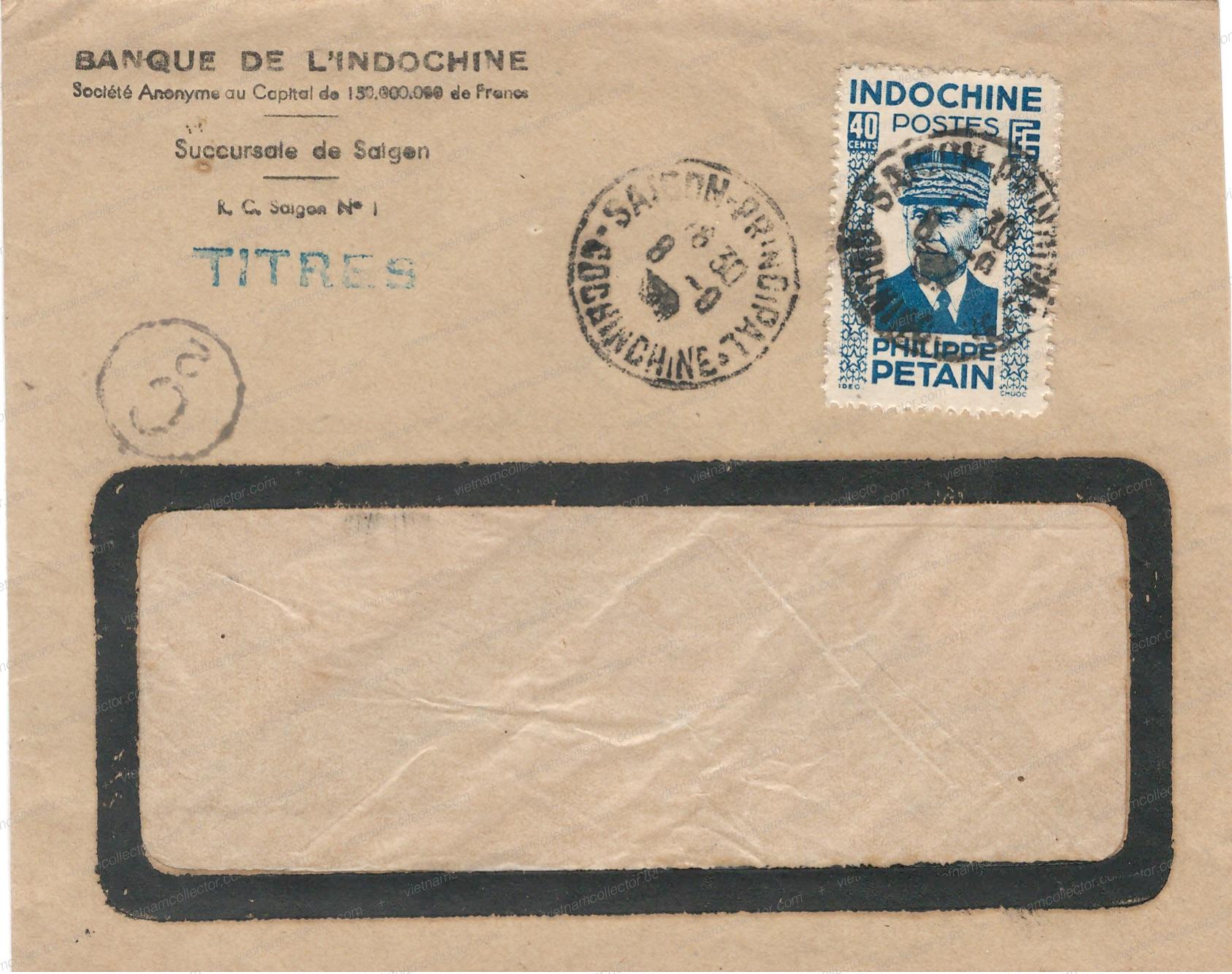
Single franking of the 40C Petain stamp paying the standard international letter rate sent on August 28th, 1945 from Mytho to Guangdong Naihai County Xiashaoyong Village in China. This was just a few days prior to the formal surrender of Japanese in World War II. Nevertheless the letter was not censored which is interesting as Guan Dong Province of China was not even occupied by the Japanese. Since the Viet Minh had already taken control of the postal system at the time and Southern China was an ally of them they probably saw no need to enact any censure. Saigon machine transfer cancel on the reverse. International letters during the Japanese occupation period are very rare and were primarily sent to Japan or places still occupied by Japan.
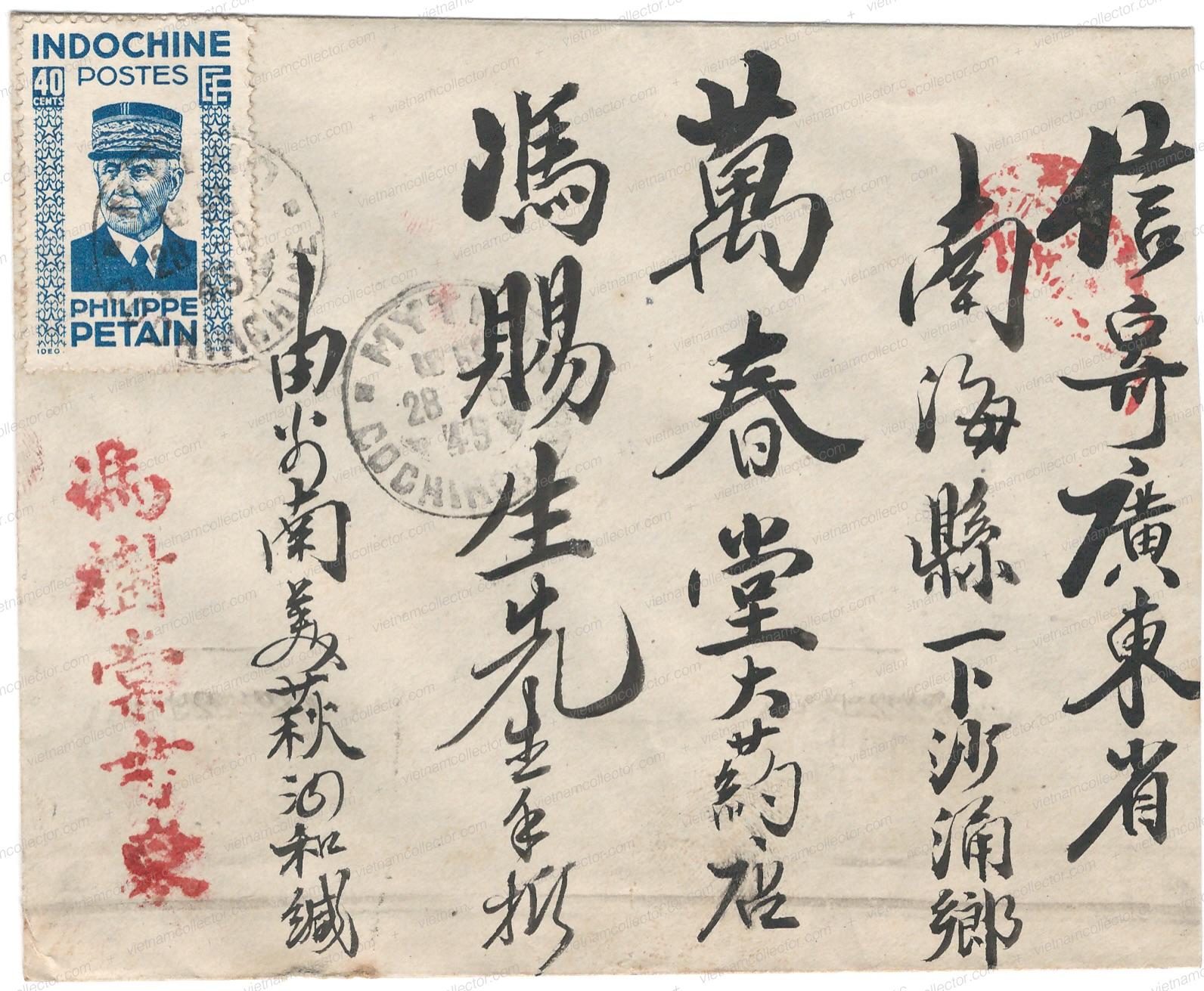
Single franking of the 40C Petain stamp paying the standard international letter rate sent on August 13th, 1945 from Saigon to Xinguang Electric Company in Guangdong Fanmenbu Xiangxing Road, Number 1 in China. This was just a two days from the informal surrender of Japanese in World War II. The letter was not censored which made sense as parts of Jianxi Province of China was still occupied by the Japanese at the time. International letters during the Japanese occupation period are very rare and were primarily sent to Japan or places still occupied by Japan.
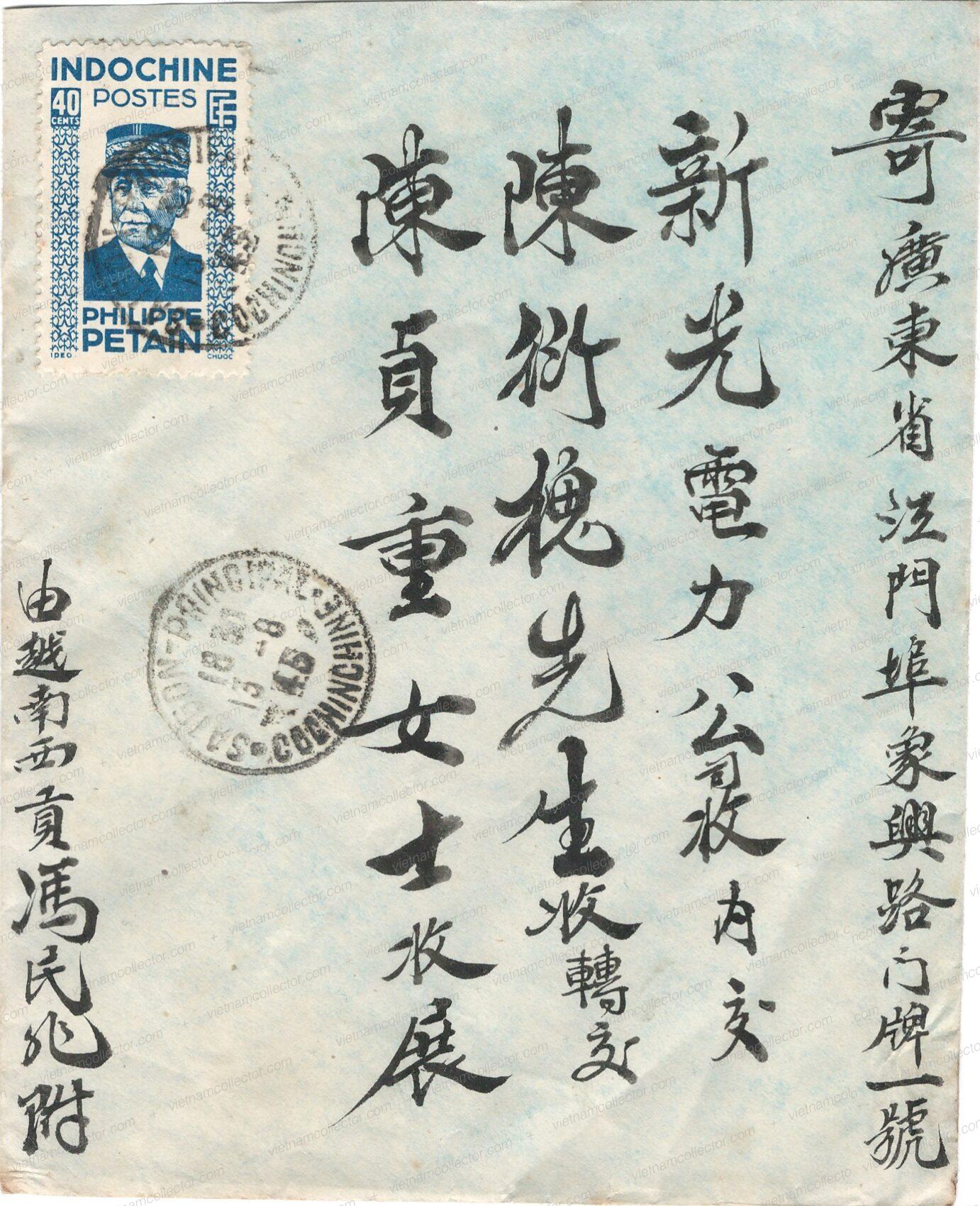
Mixed franking of the 40C Petain stamp (blue-green) together with the 5C Grandiere stamp in brown color paying an overall postage of 45C on a domestic registered letter sent from Cholon to Saigon in January of 1945. Note the unusual manual R Code in blue color. The letter was addressed to “Chef de la Inspection General de Mines” in Hanoi in August of 1943. This post was held by the well known philatelist Jacques Dessrousseaux. Saigon arrival cancel on the reverse. Ex Dessrousseaux.
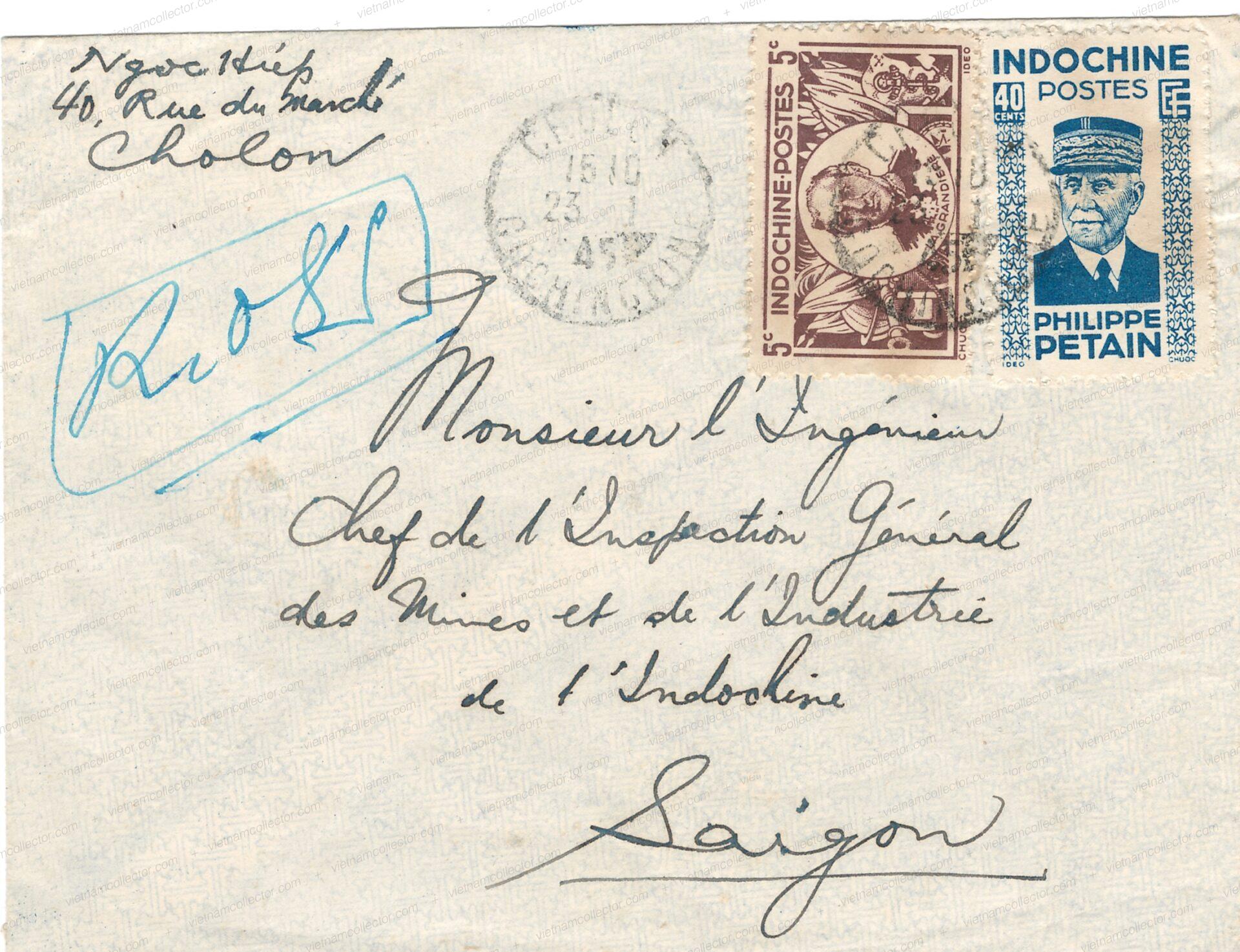
Registration Nr. 090370

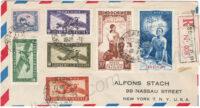
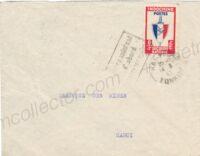
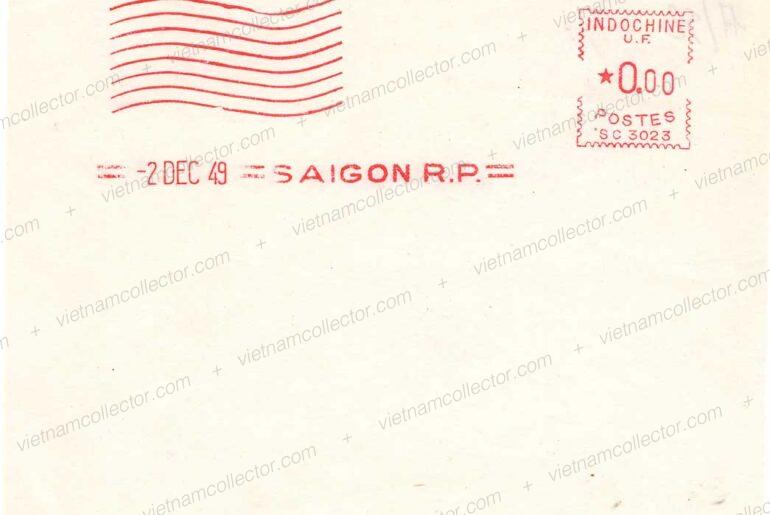
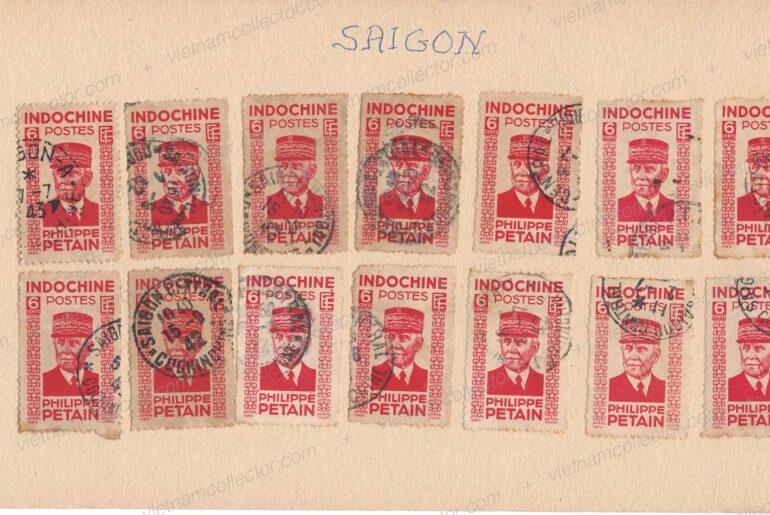
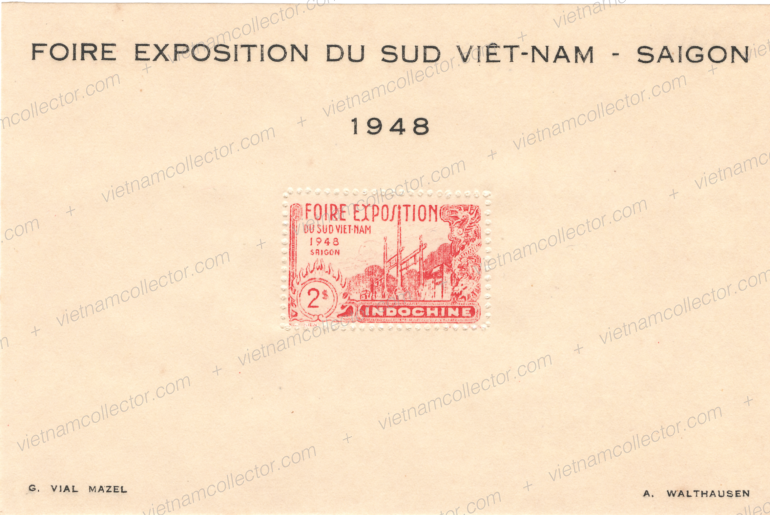
Comments are closed.